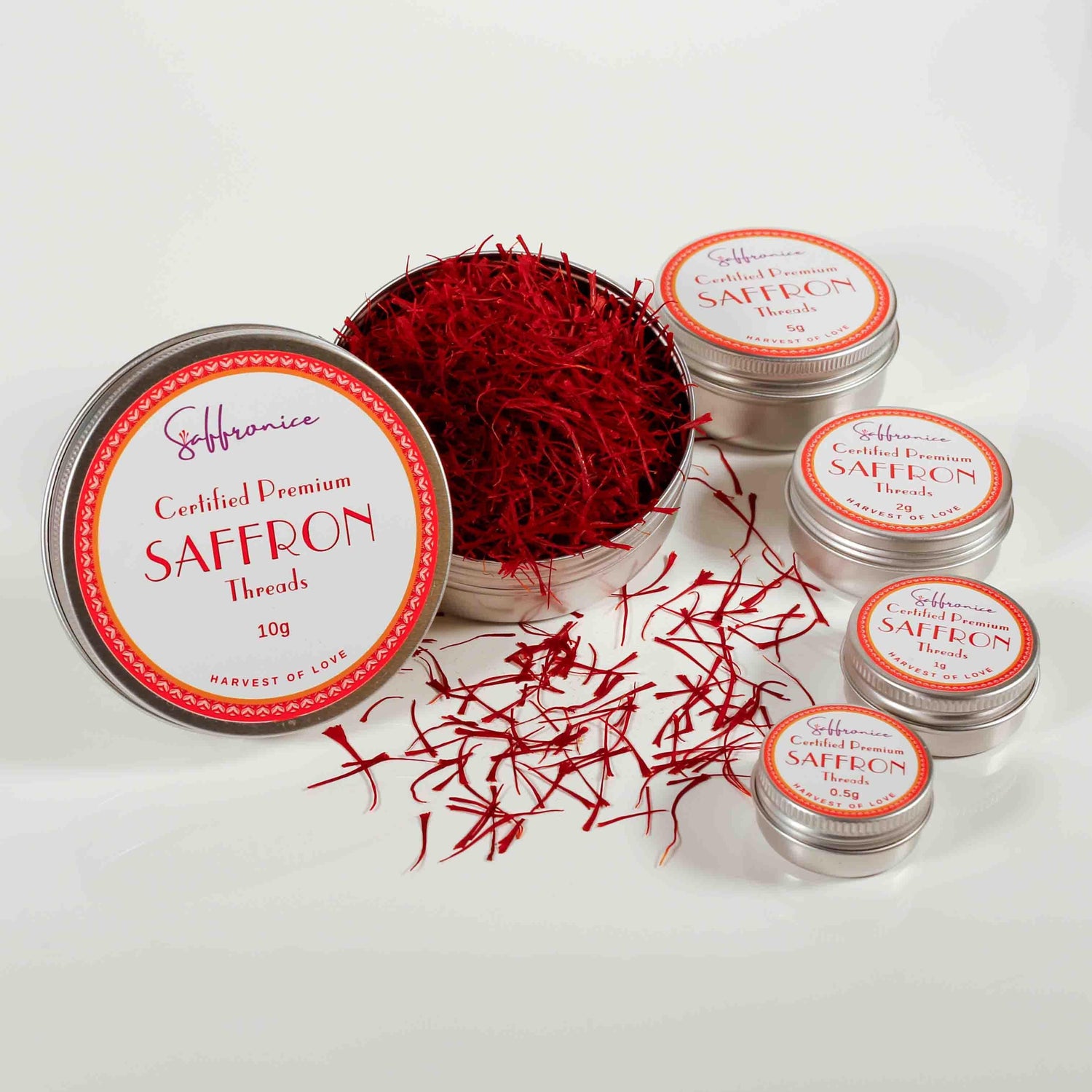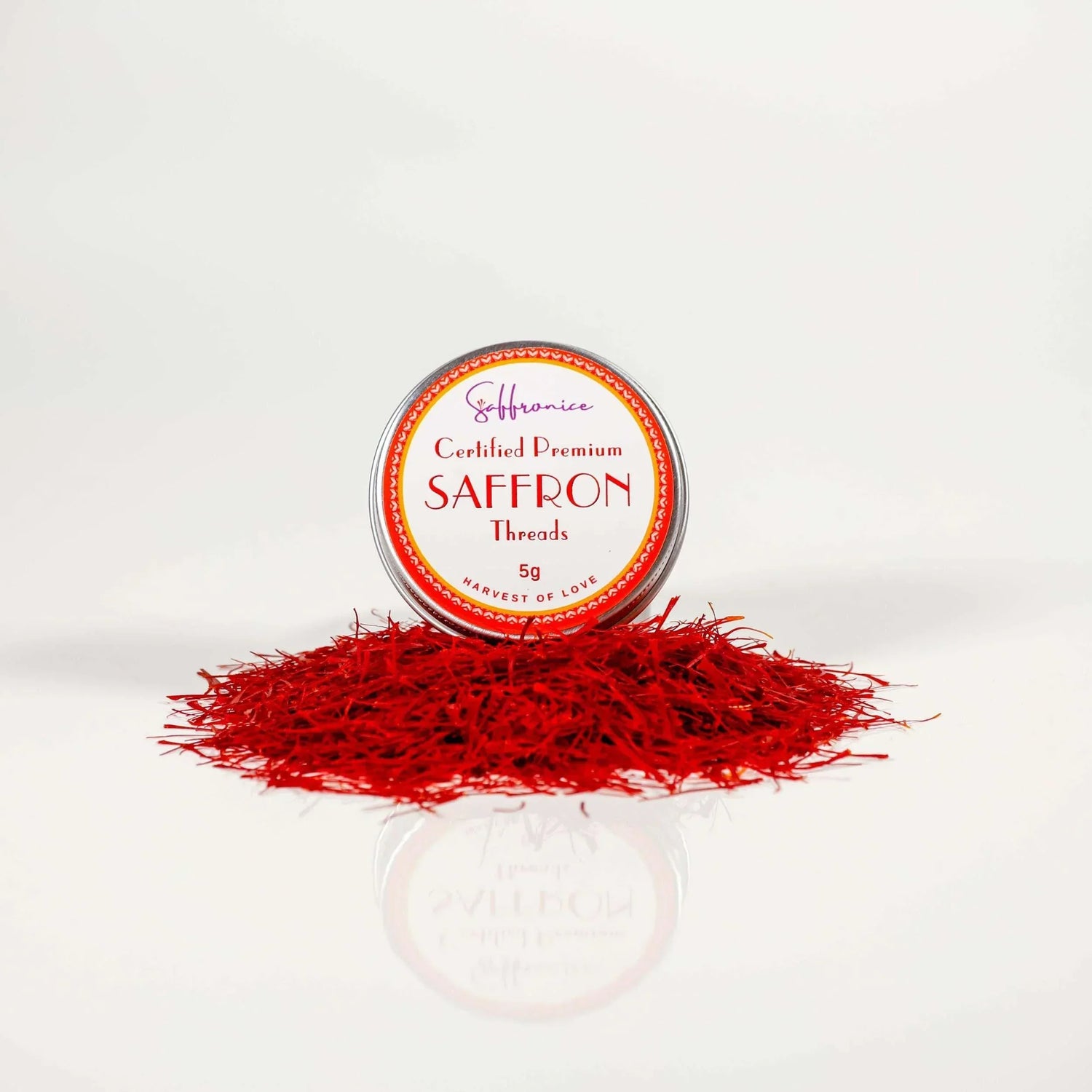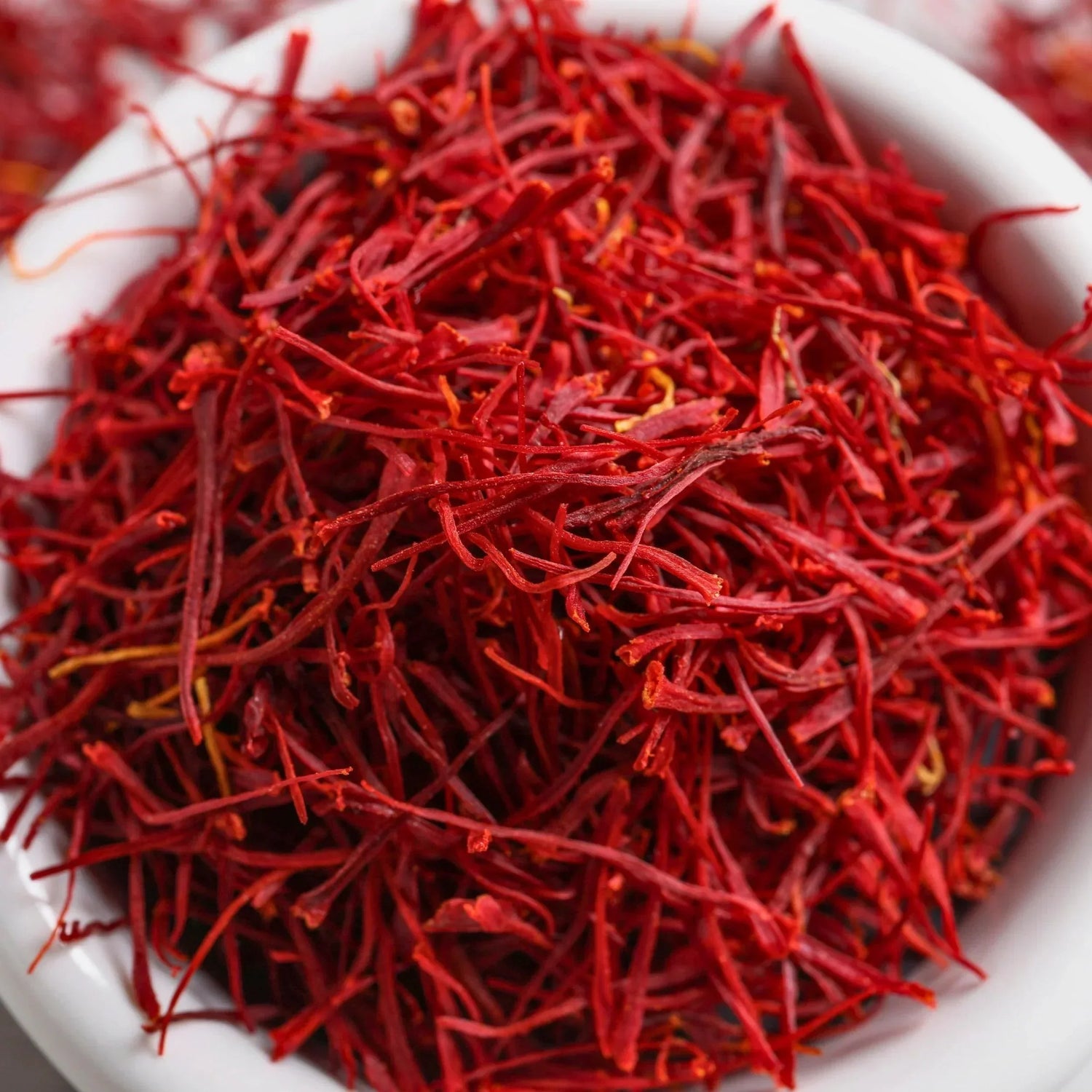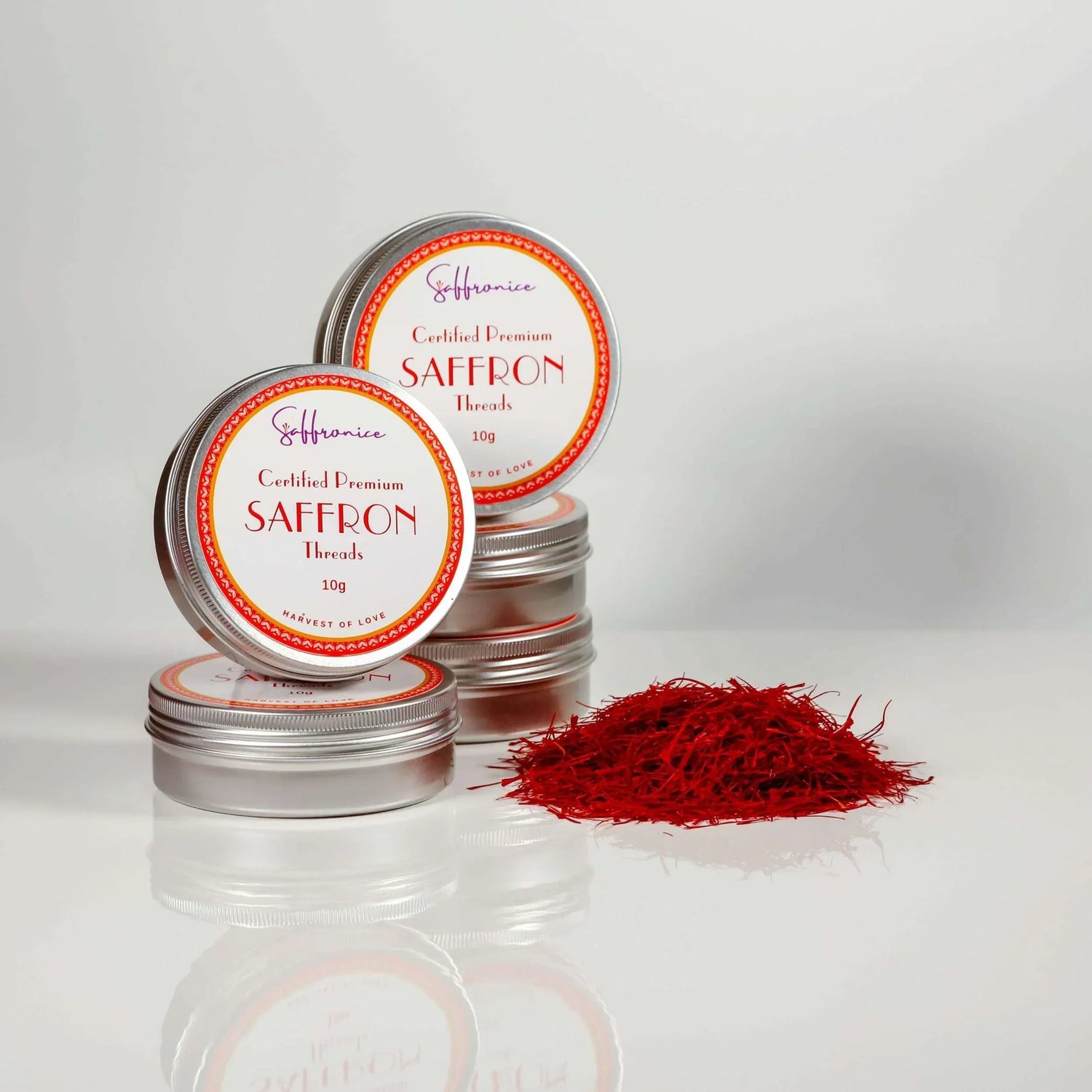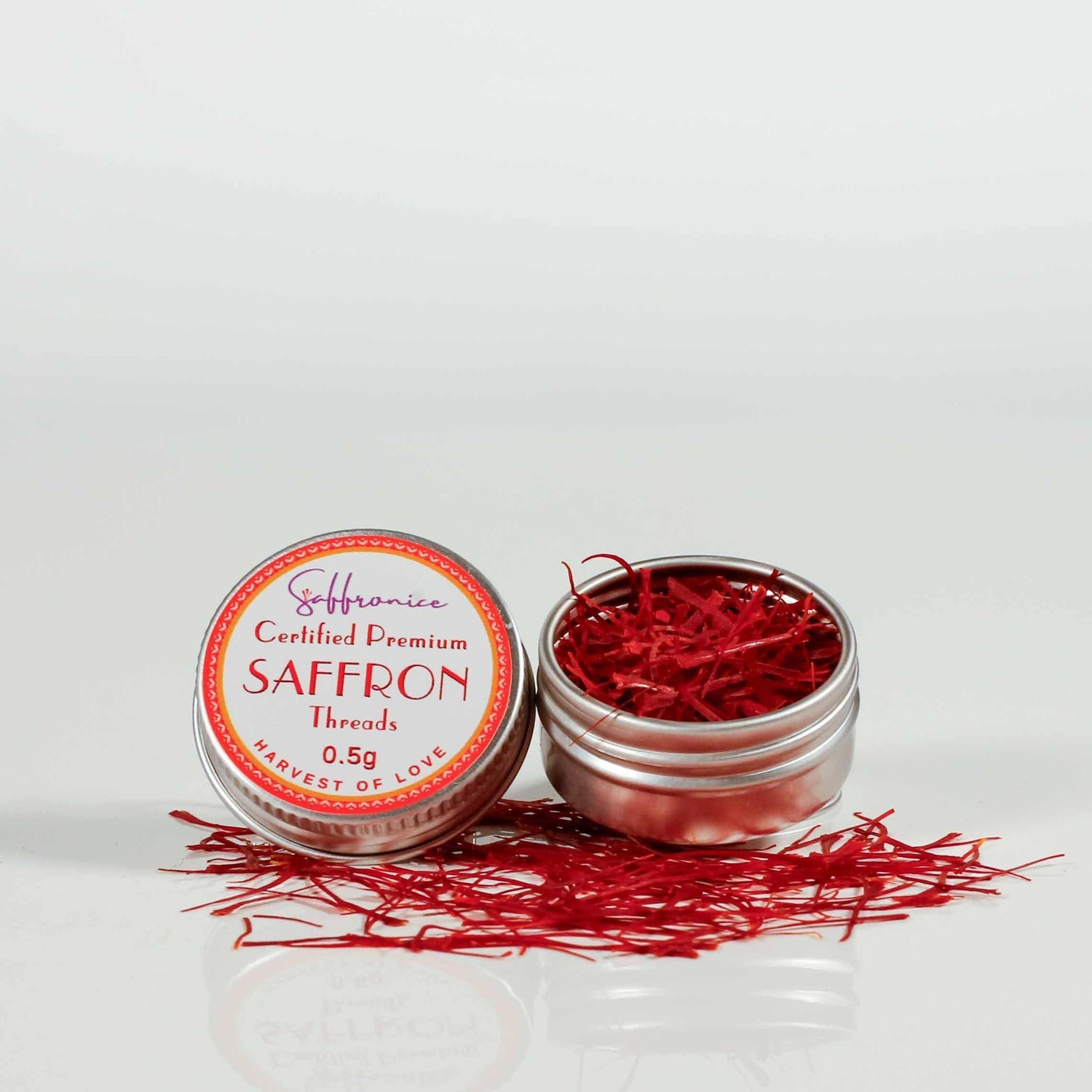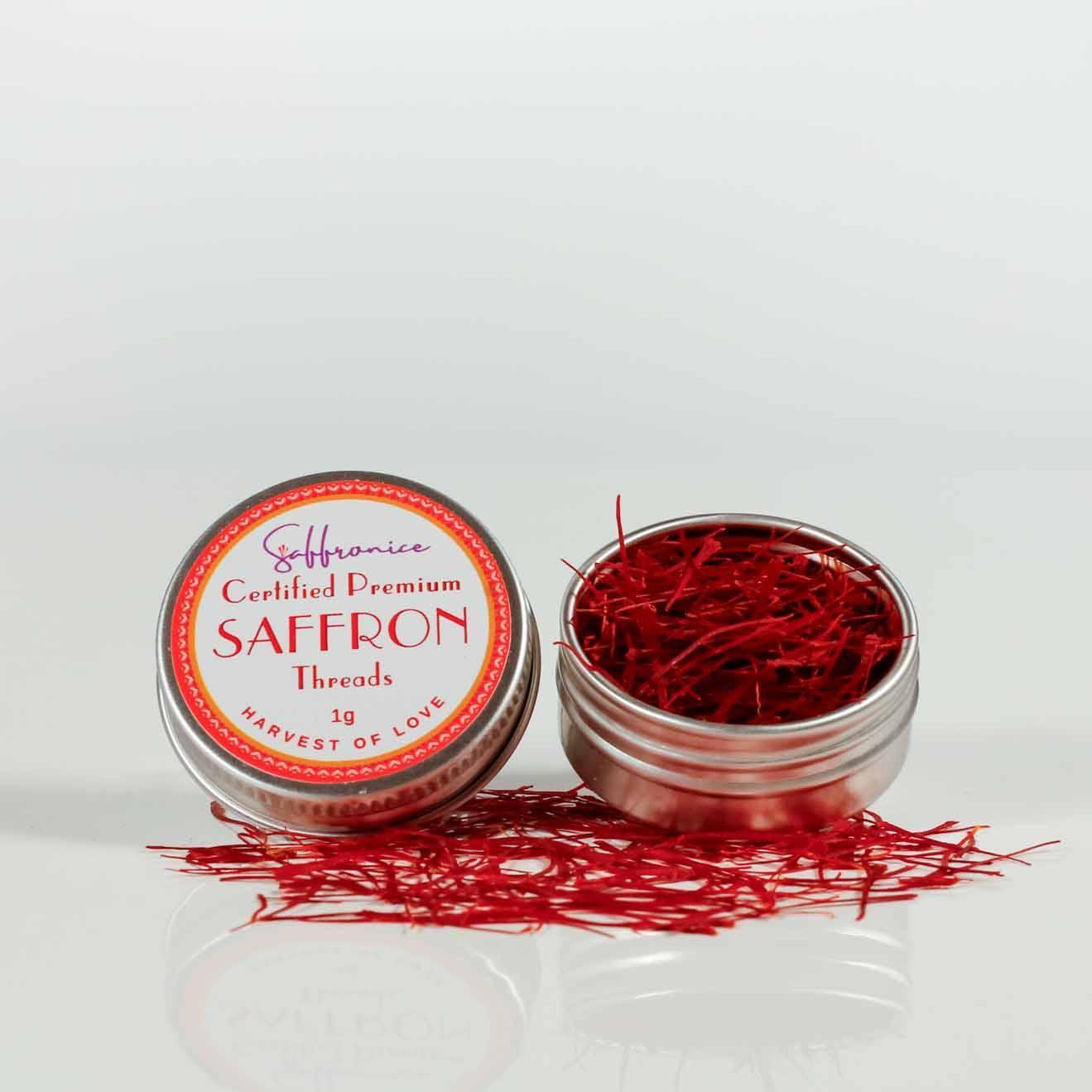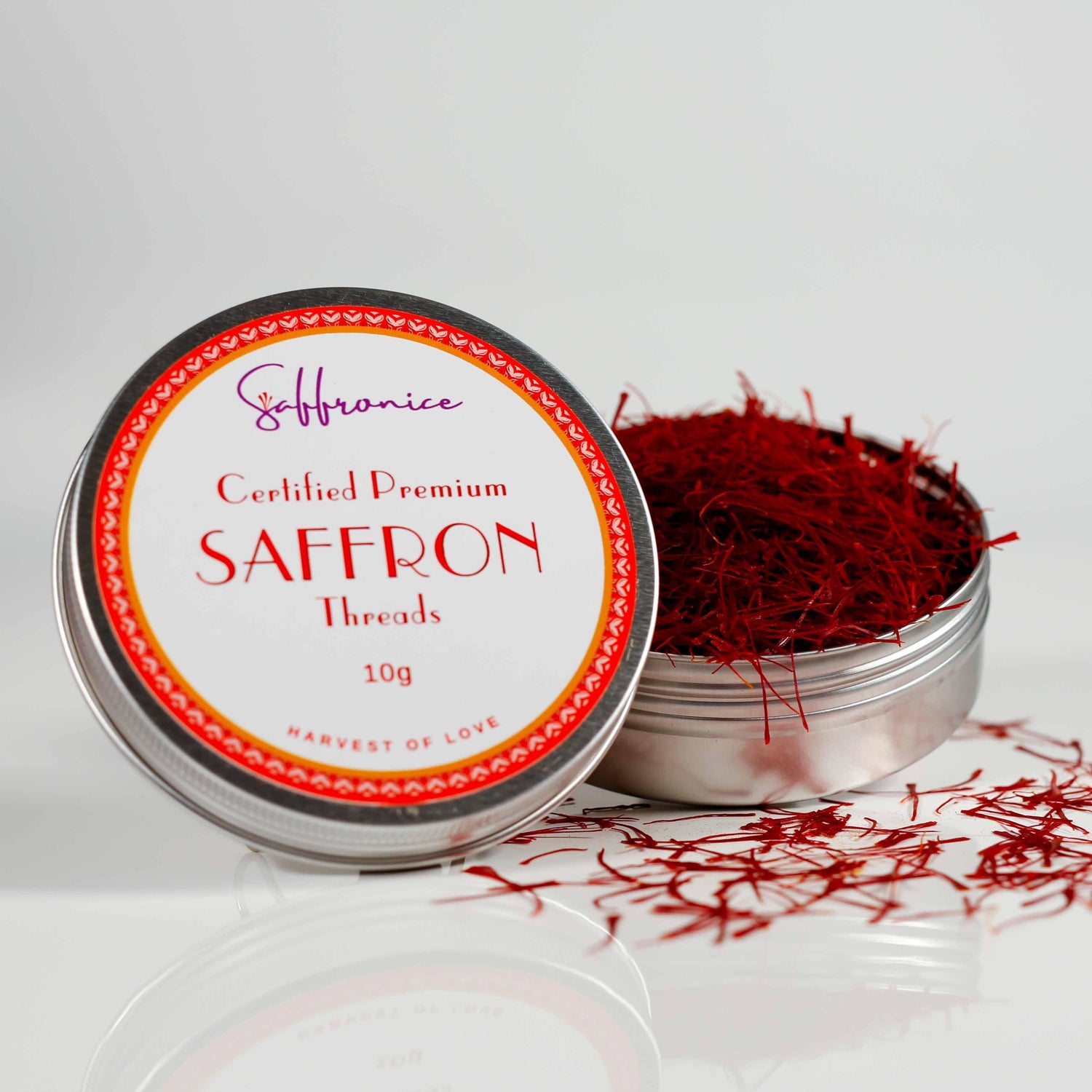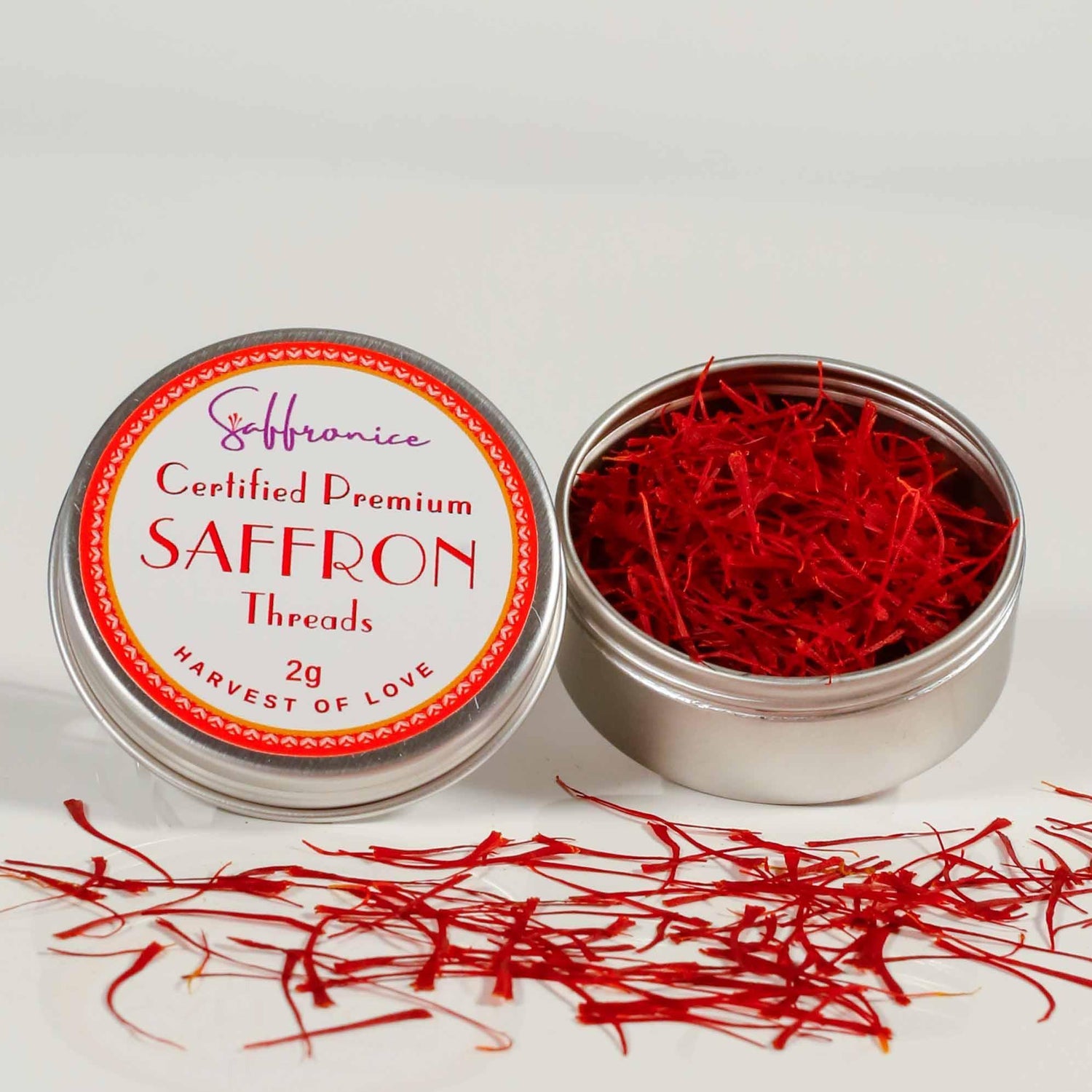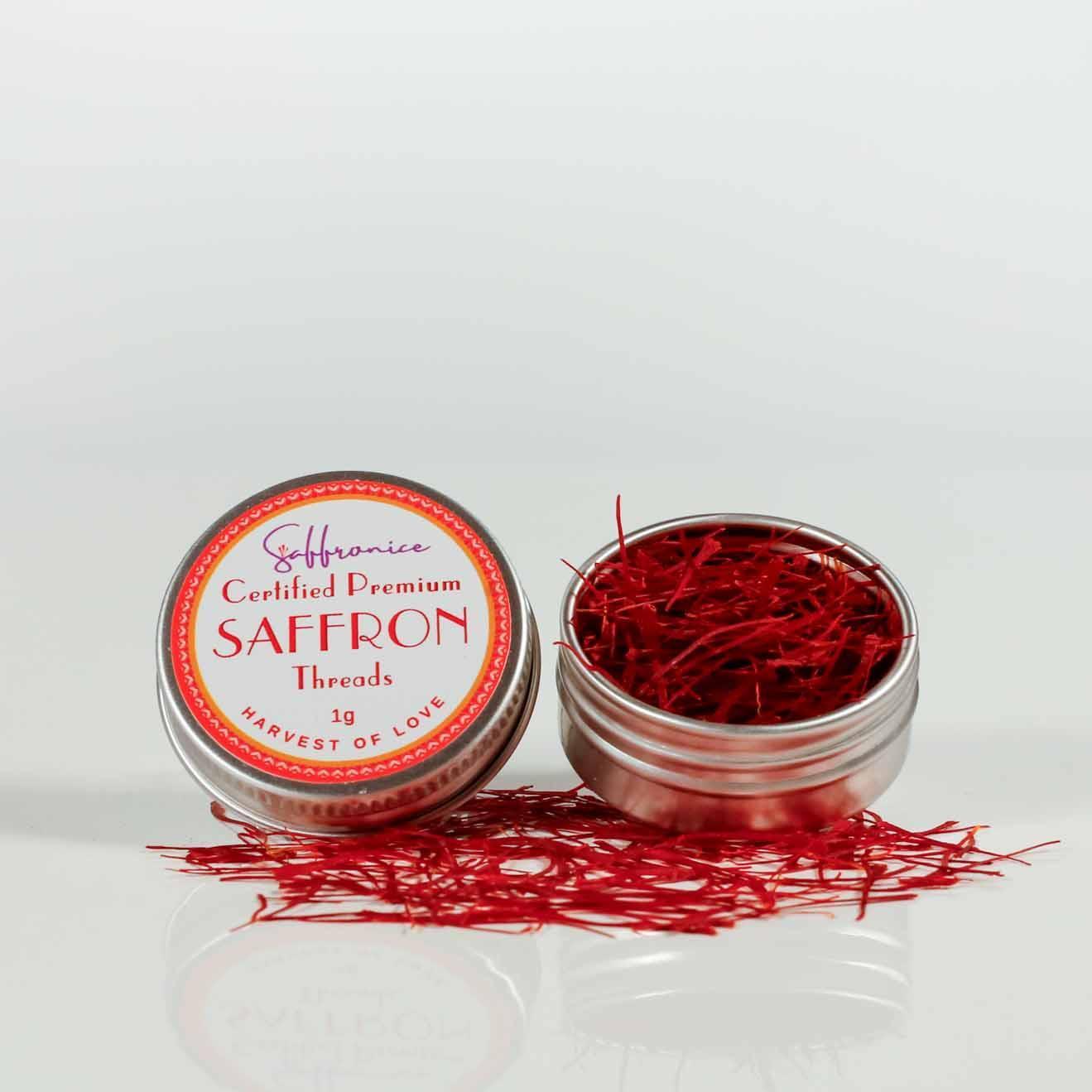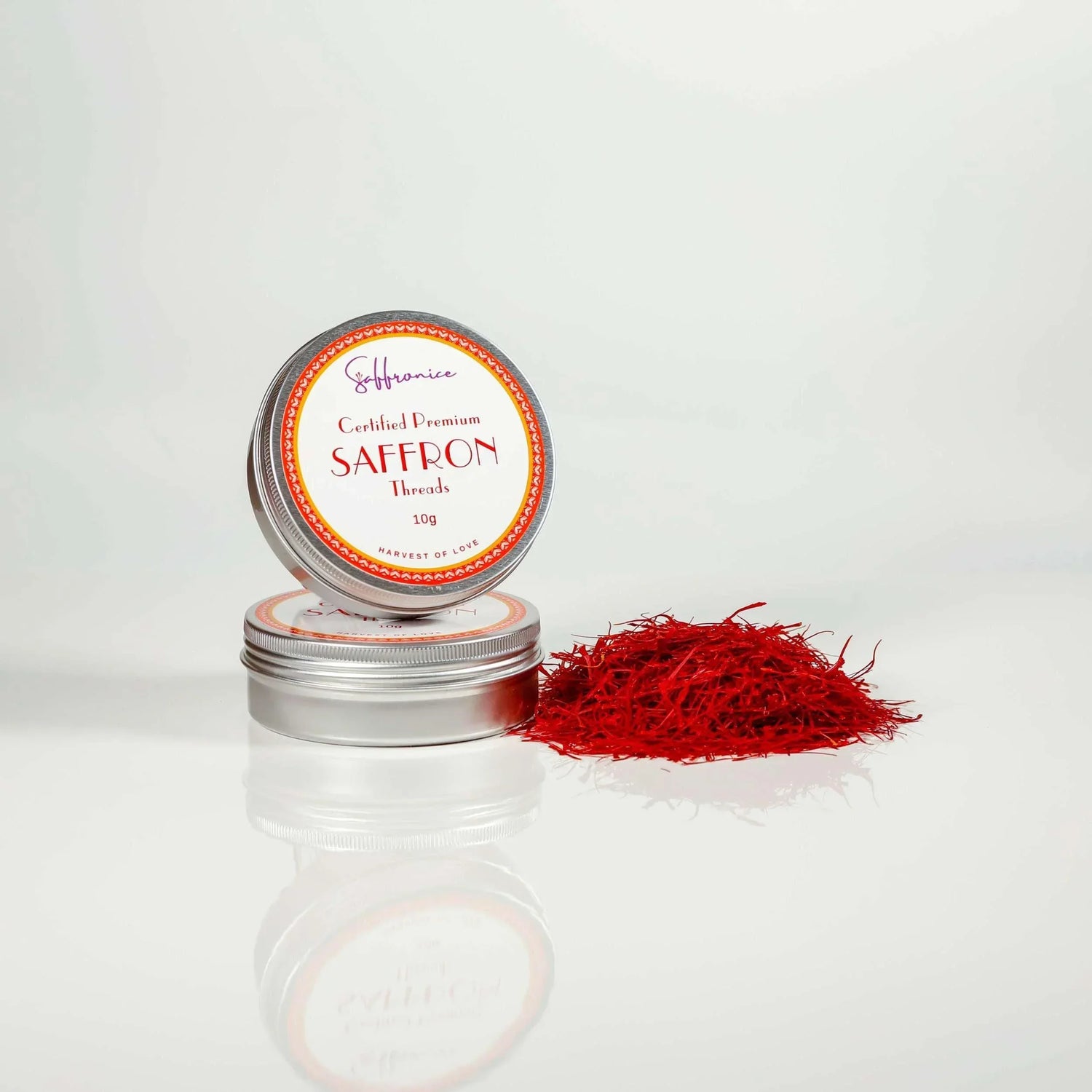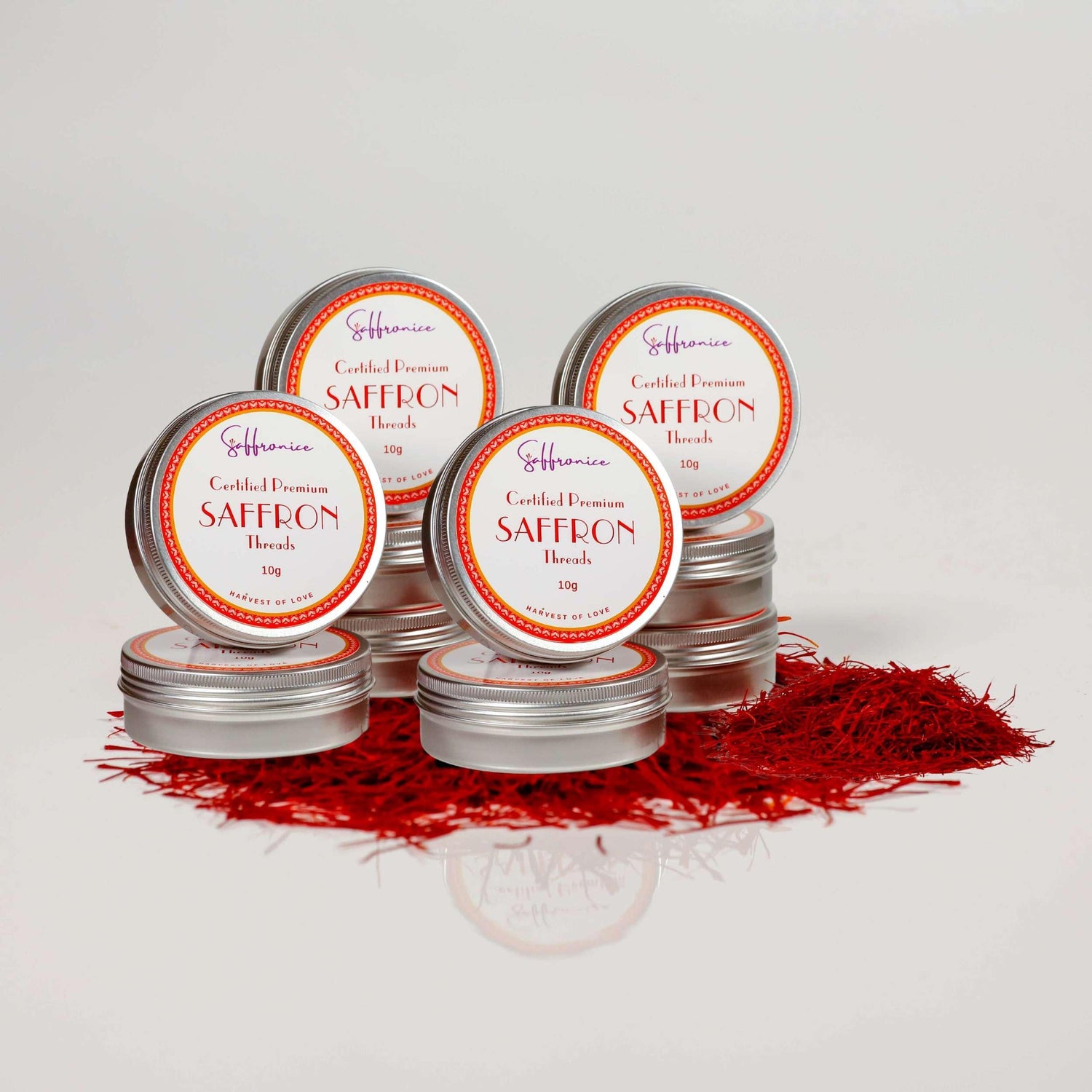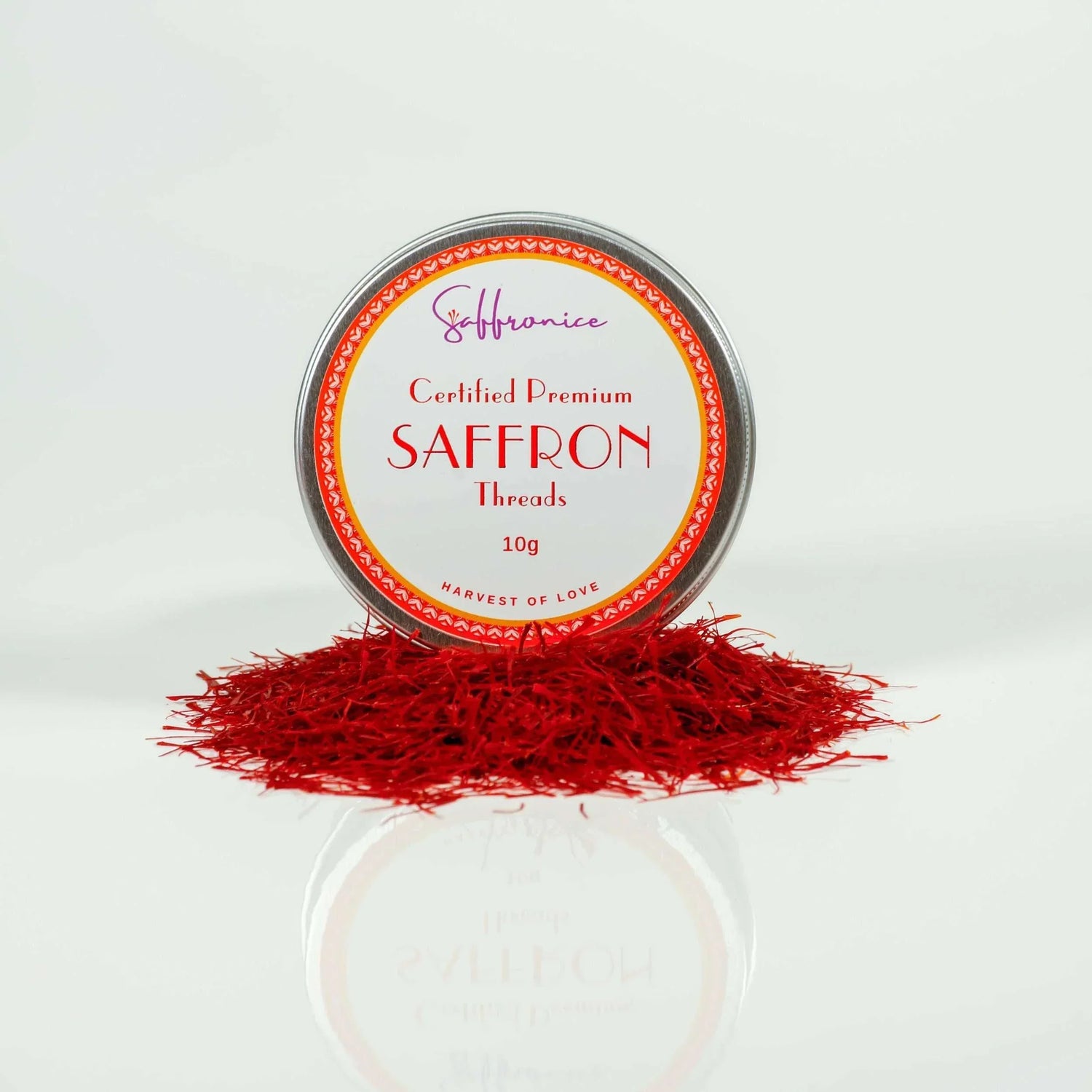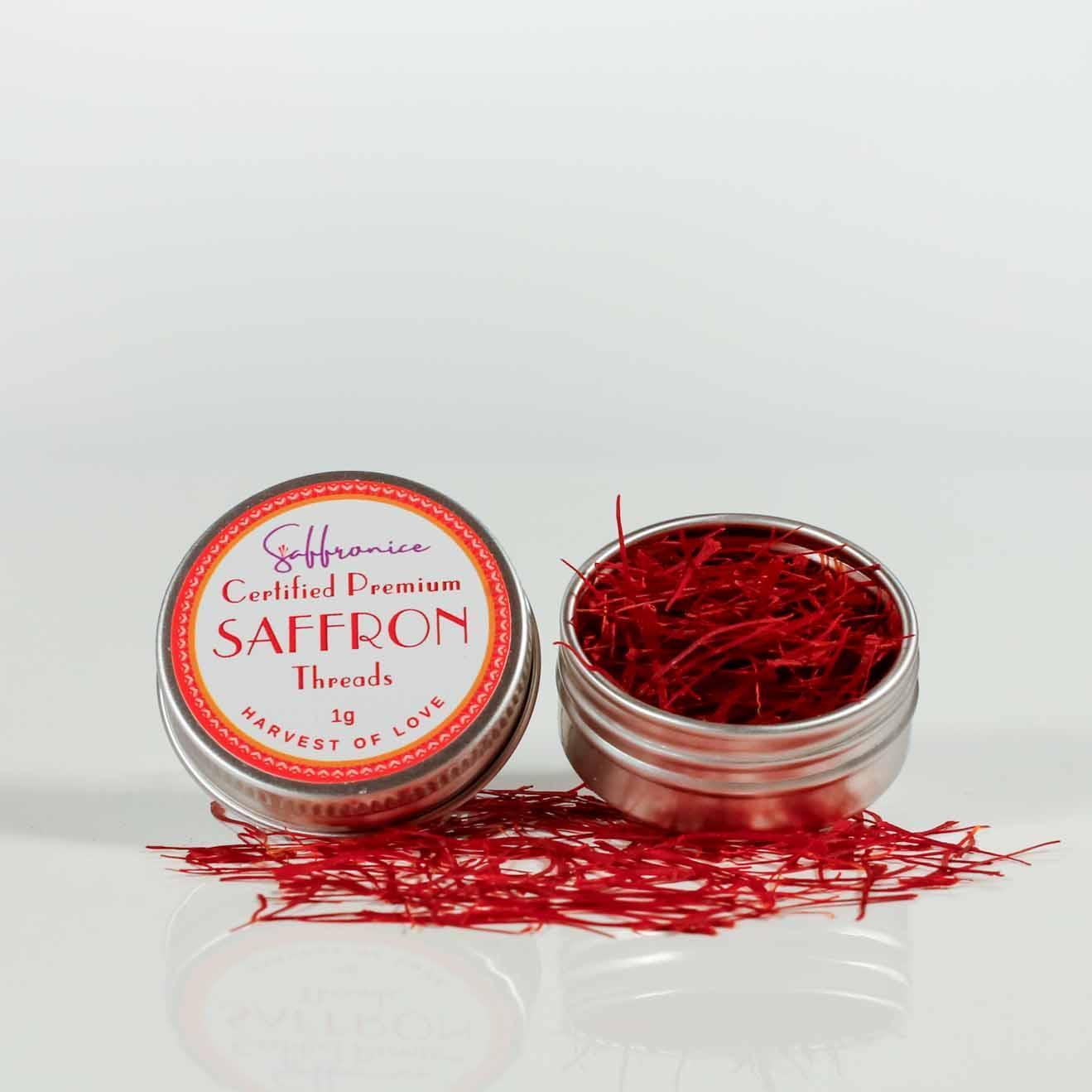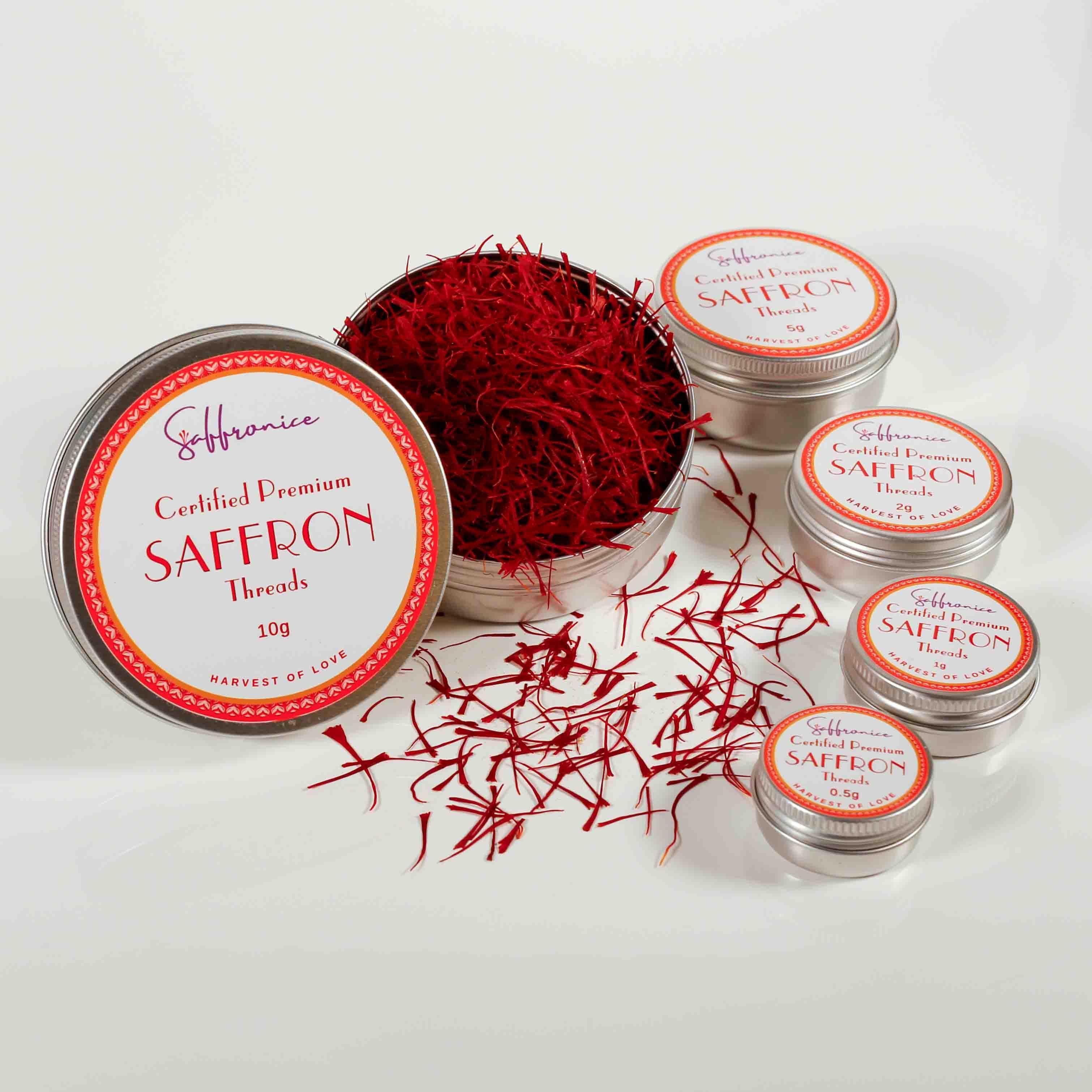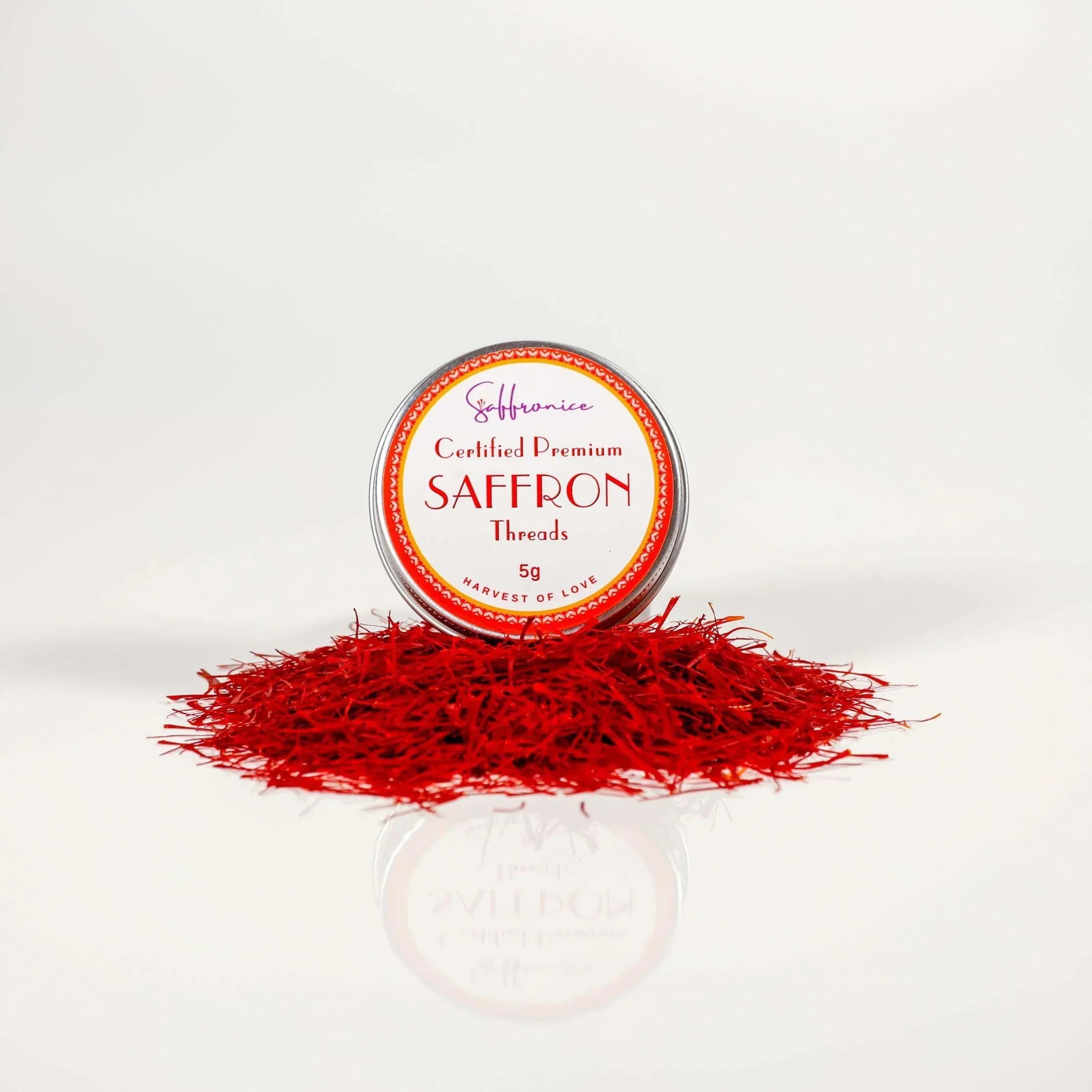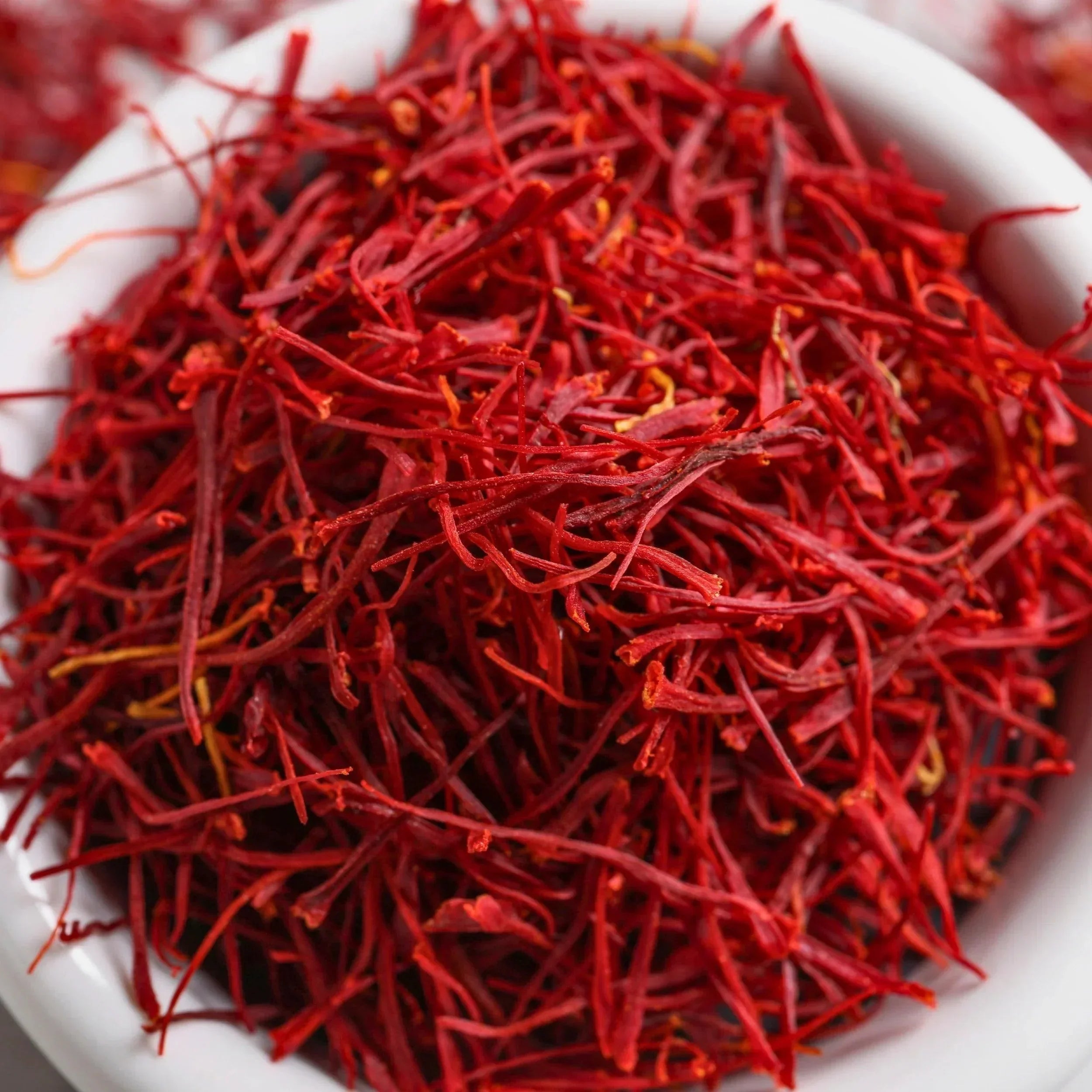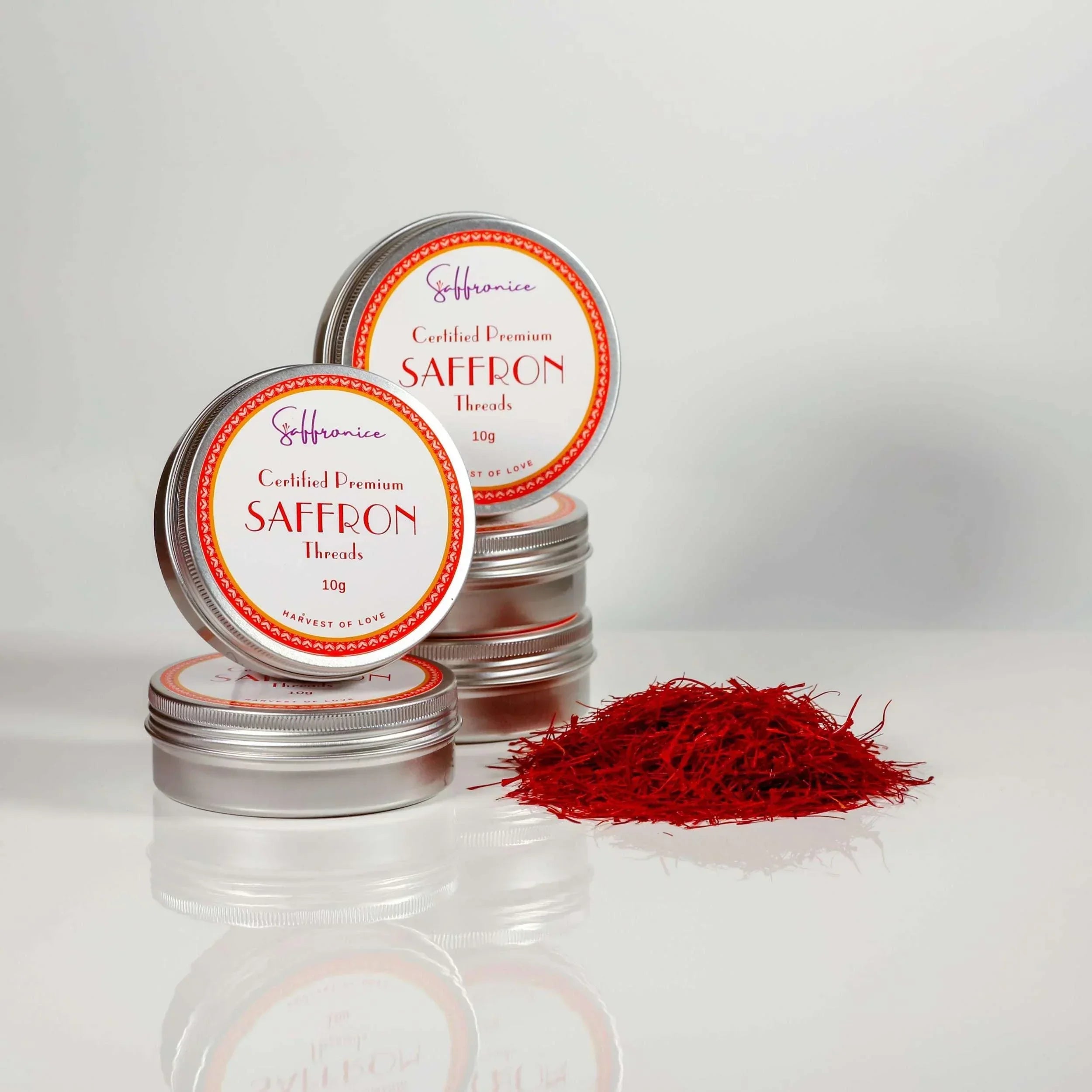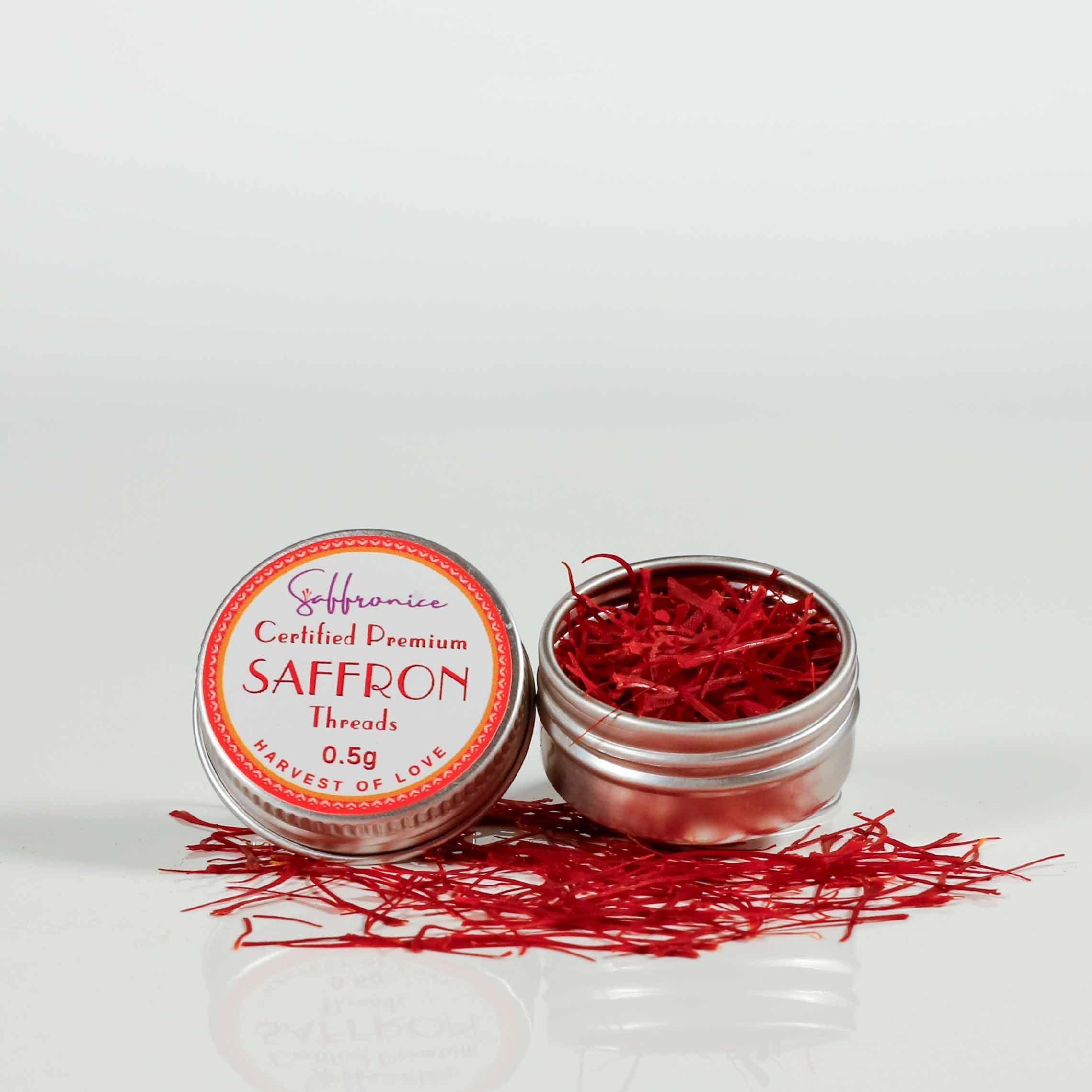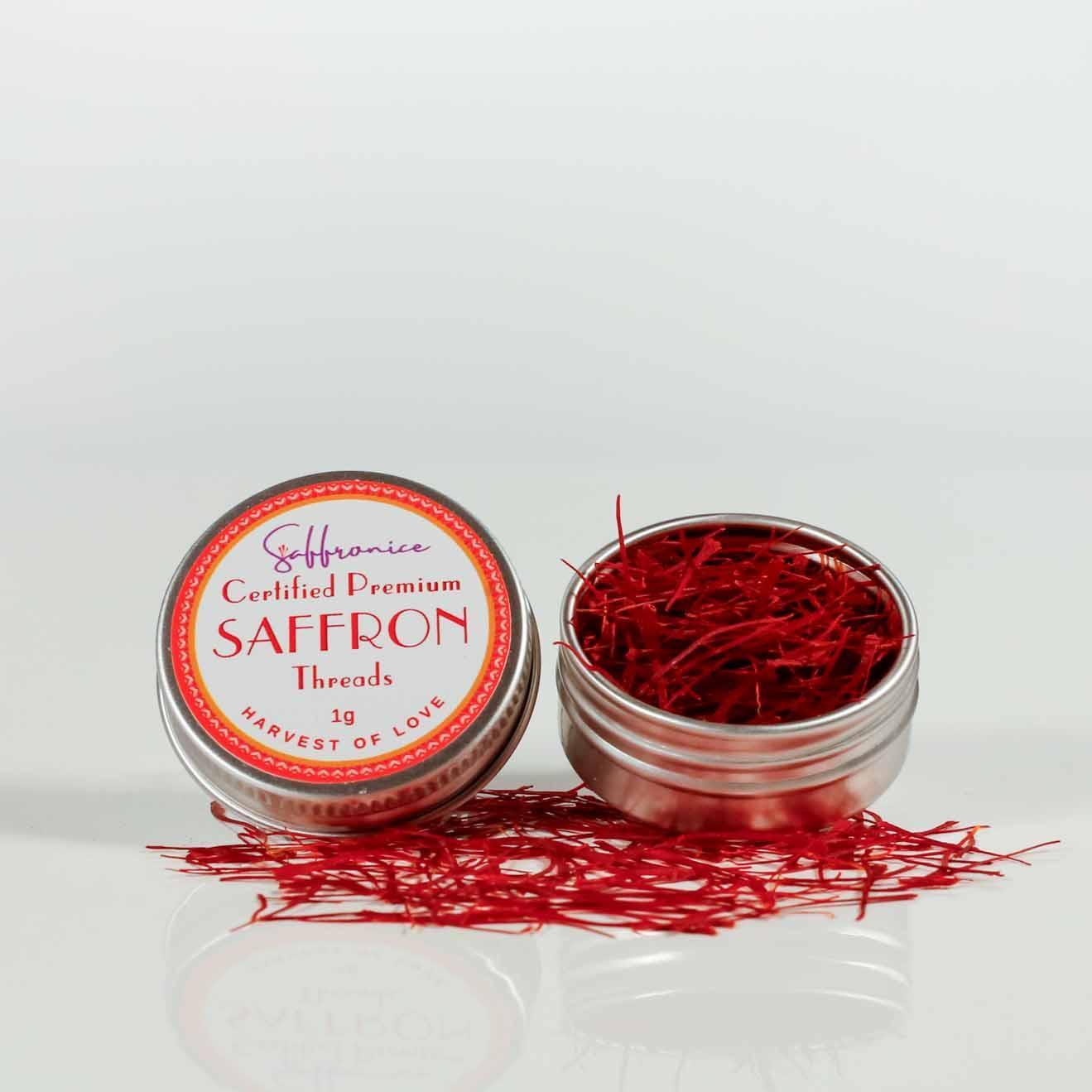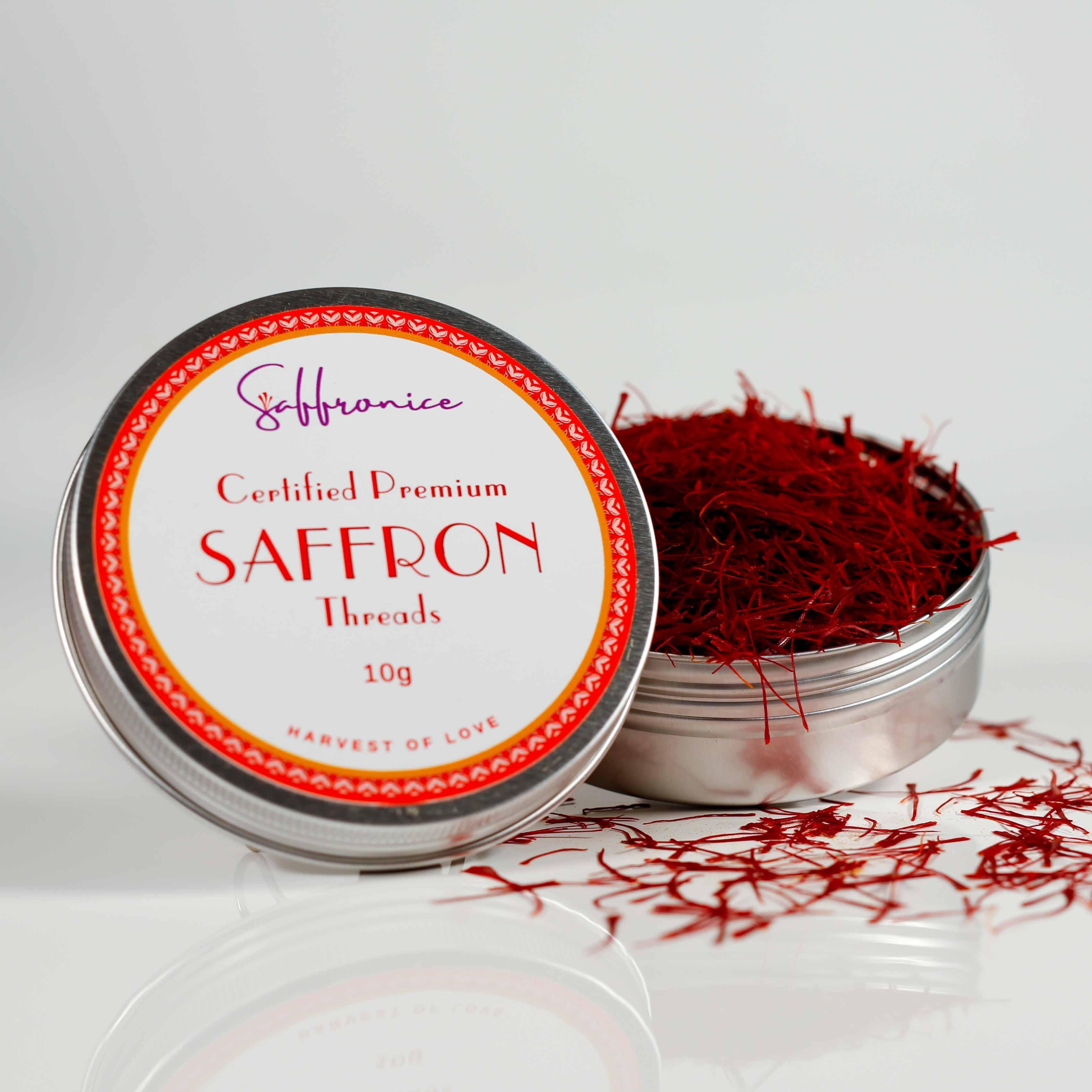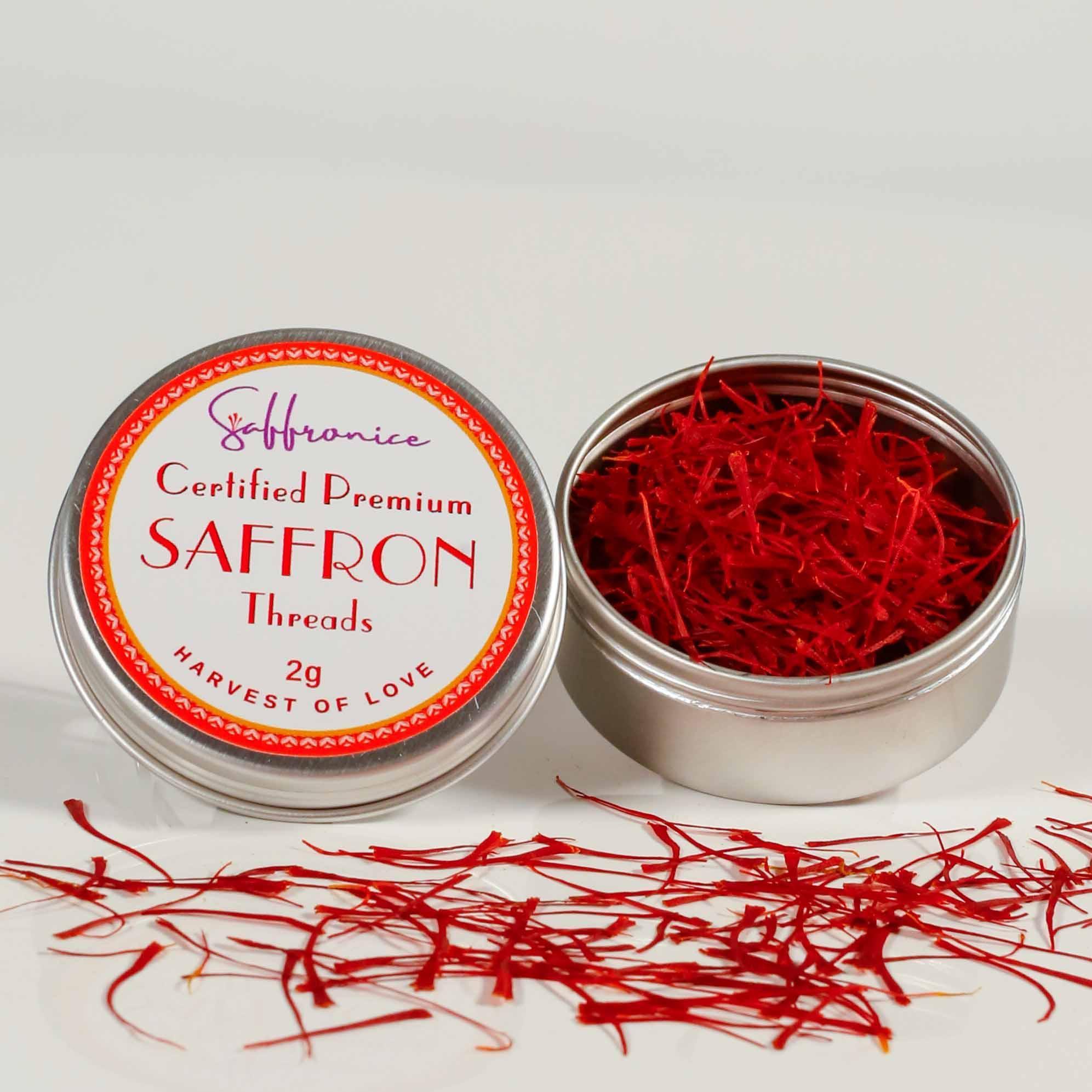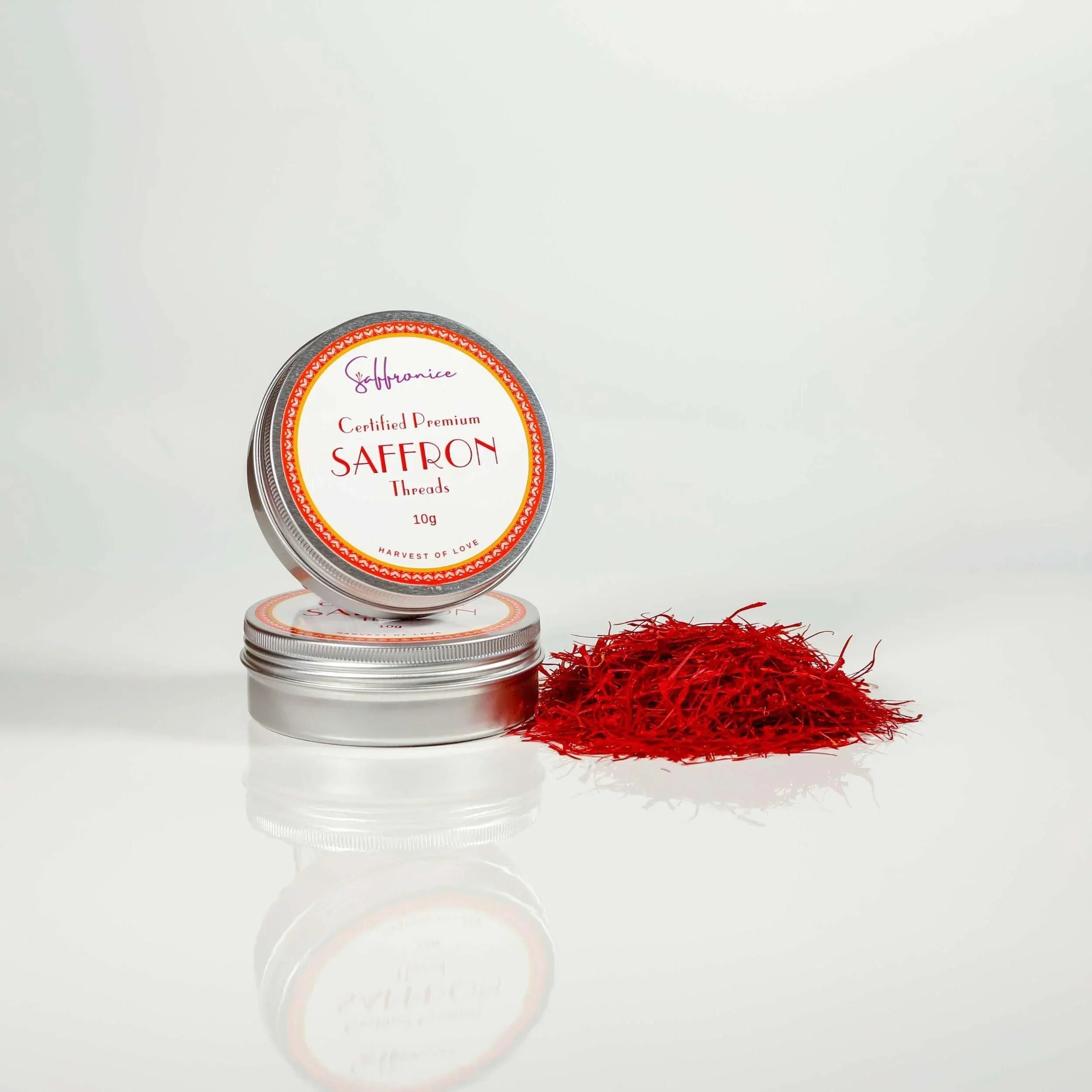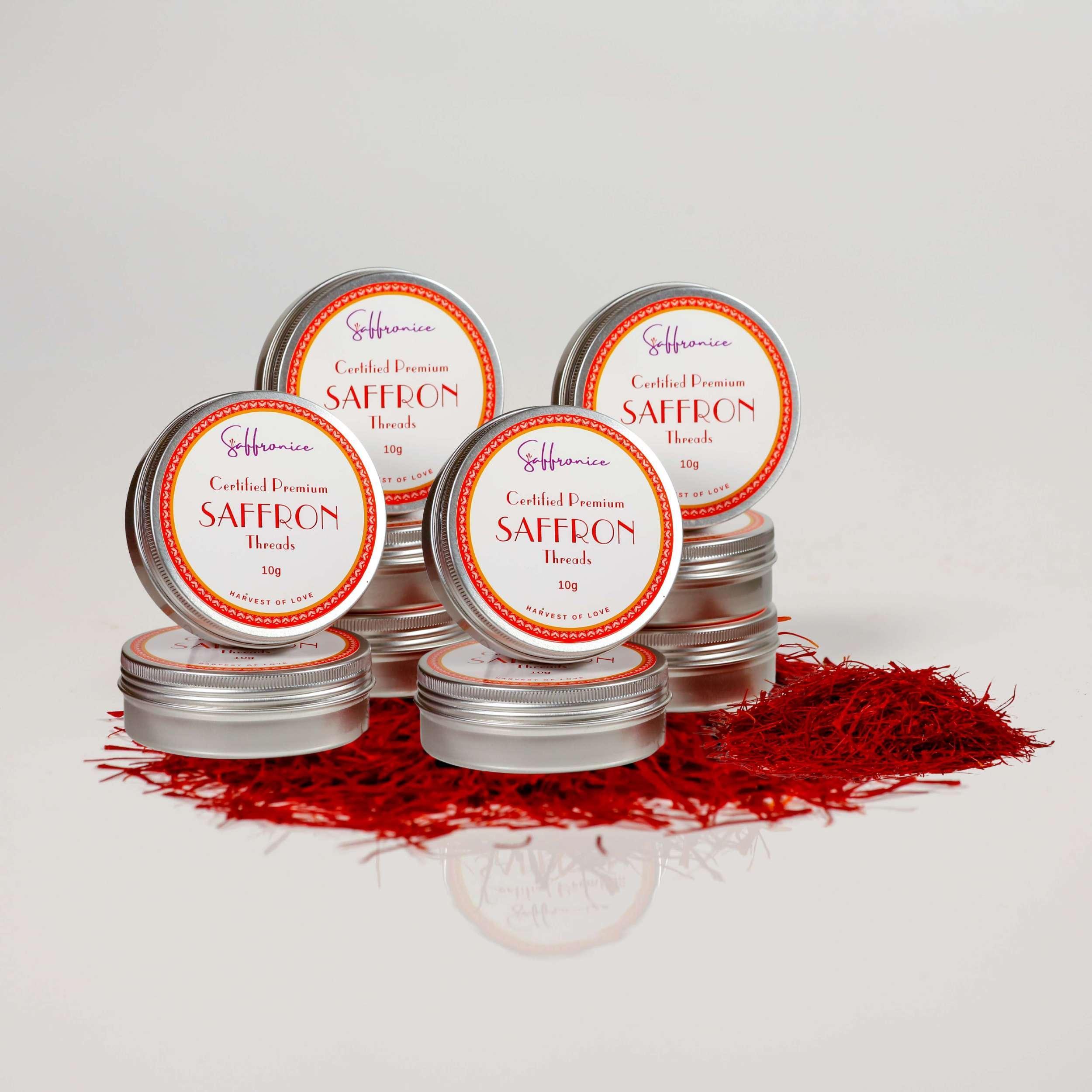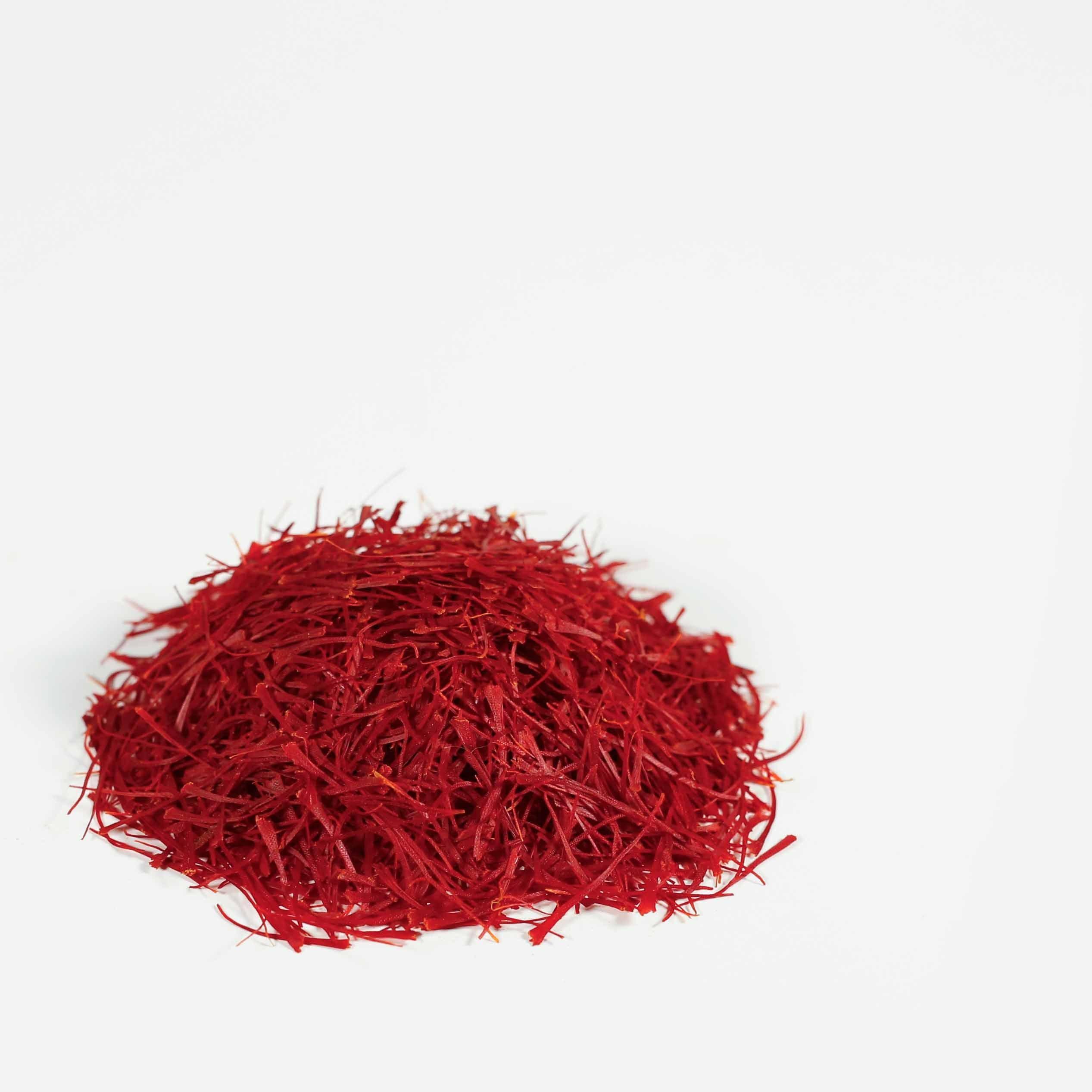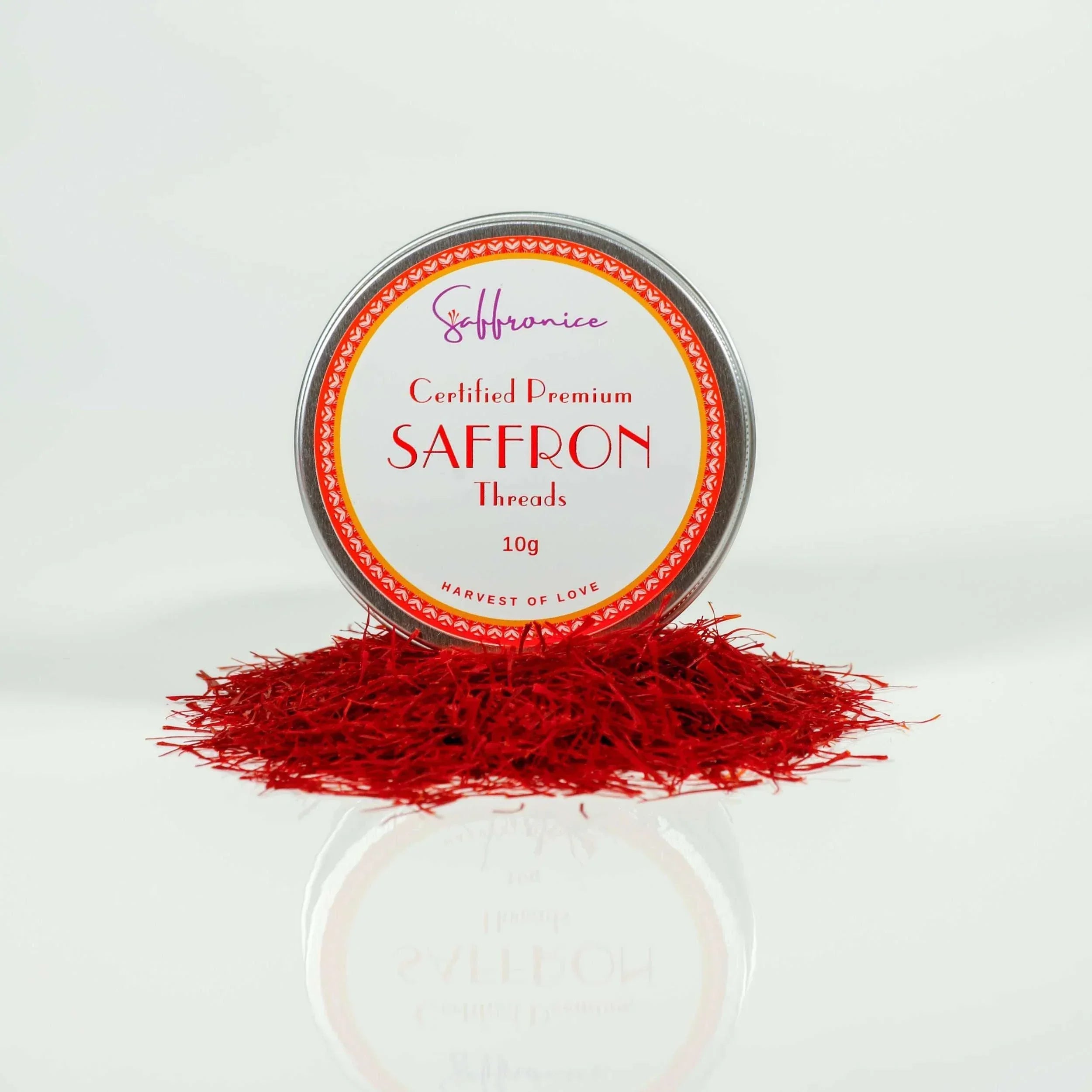Saffron, derived from the dried stigmas of the Crocus sativus flower, is often referred to as the "golden spice" due to its vibrant hue and high value (Srivastava et al., 2010). This precious spice has garnered significant attention not only in culinary circles but also in traditional medicinal systems, particularly Ayurveda (Ravindran, 2007).
Ayurveda, an ancient system of medicine originating in India, regards saffron as a multifaceted herb with numerous health benefits (Sharma et al., 2012). Historically, saffron holds a revered place in Ayurvedic practices for its ability to balance the body's doshas—Vata, Pitta, and Kapha—and enhance overall well-being (Khajuria et al., 2019).

Multifaceted Benefits of Saffron in Ayurvedic Medicine:
- Blood Purification: Saffron is known for its purifying properties, helping to cleanse the blood and improve circulation (Hosseinzadeh & Nassiri-Asl, 2013).
- Skin Enhancement: Classified under the "Varnya Gana" group, saffron is prized for its ability to enhance skin appearance and treat various skin conditions (Sharma et al., 2012).
- Mental Health Support: Traditionally used for mood enhancement and cognitive function improvement, saffron assists in alleviating symptoms of depression and anxiety (Moshiri et al., 2015).
- Reproductive Health: Its aphrodisiac properties aid in treating infertility and regulating menstrual cycles (Fatehi et al., 2008).
- Anti-inflammatory Effects: Saffron's bioactive compounds provide anti-inflammatory benefits that support immune function and overall health (Khorasany & Hosseinzadeh, 2016).
Exploring saffron within Ayurveda unveils its broad spectrum of applications, making it an indispensable component of holistic wellness practices.
Saffron in Ayurveda
Saffron, known as Kesar in Sanskrit, is highly valued in Ayurveda for its powerful healing properties (Sharma et al., 2012). It is classified as a tridoshic herb, meaning it has the ability to balance all three doshas: Vata, Pitta, and Kapha (Dash & Sharma, 2018). This balance is essential for maintaining overall health, as imbalances in these doshas can lead to various health issues (Tiwari et al., 2014).
Balancing the Doshas
- Vata Dosha: Saffron's warming properties help soothe and stabilize the erratic nature of Vata, which governs movement and communication in the body (Dash & Sharma, 2018).
- Pitta Dosha: Its cooling essence calms the fiery nature of Pitta, responsible for metabolism and transformation (Sharma et al., 2012).
- Kapha Dosha: By stimulating circulation and reducing congestion, saffron effectively counteracts the heavy and sluggish characteristics of Kapha (Tiwari et al., 2014).
Traditional Uses
Ayurvedic practices have incorporated saffron in numerous ways:
- Blood Purification: Saffron is used to purify the blood and improve circulation (Hosseinzadeh & Nassiri-Asl, 2013).
- Digestive Aid: It aids digestion by enhancing appetite and alleviating digestive issues (Modaghegh et al., 2008).
- Skin Health: Traditionally, saffron has been applied to improve skin complexion and treat skin diseases (Khajuria et al., 2019).
- Reproductive Health: Known for its aphrodisiac properties, saffron helps treat infertility and sexual dysfunction (Fatehi et al., 2008).
Incorporating saffron into daily routines can be as simple as adding it to Ayurvedic teas or recipes. Its versatility makes it a staple in Ayurvedic medicine, offering a natural solution for achieving balance and wellness.
Healing Properties of Saffron in Ayurveda
1. Mood Enhancement and Mental Health Support
Saffron has been used for centuries in Ayurveda as a natural remedy for depression and mood disorders (Akhondzadeh et al., 2005). This vibrant spice is known for its ability to uplift spirits and promote emotional well-being.
How Saffron Works
In Ayurveda, it is believed that saffron works by balancing the body's doshas, particularly Vata and Pitta doshas (Dash & Sharma, 2018). When these doshas are out of balance, it can lead to mental health issues such as anxiety and depression. By harmonizing these energies, saffron helps restore emotional equilibrium.
The Science Behind Saffron's Effects
Recent studies have also shed light on the potential mechanisms through which saffron exerts its antidepressant effects. The key bioactive compounds found in saffron—crocin, picrocrocin, and safranal—are thought to influence neurotransmitter activity in the brain, particularly serotonin levels (Moshiri et al., 2015). Serotonin is a neurotransmitter that plays a crucial role in regulating mood.
2. Anxiety Relief
In addition to its mood-enhancing properties, saffron has also shown promise in alleviating symptoms of anxiety (Hausenblas et al., 2015). Ayurvedic practitioners attribute anxiety to an aggravated Vata dosha, which can result in restlessness and excessive worry (Dash & Sharma, 2018).
Saffron's Calming Influence
By stabilizing Vata through its tridoshic nature, saffron may help calm the mind and reduce feelings of anxiety (Sharma et al., 2012). This makes it a valuable addition to Ayurvedic treatments for individuals struggling with anxious thoughts or panic attacks.
3. Cognitive Function Support
Saffron's benefits extend beyond emotional well-being; it may also support cognitive function. Ayurvedic traditions have long recognized the positive effects of this spice on memory retention and mental clarity (Poma et al., 2012).
Antioxidant Protection for Brain Health
The antioxidant properties of saffron are believed to play a significant role in safeguarding brain cells from oxidative damage—an important factor in maintaining cognitive abilities as we age (Ochiai et al., 2007). By incorporating saffron into our diets or herbal formulations, we may potentially enhance memory recall and overall cognitive performance.
4. Practical Uses of Saffron
To reap the benefits of saffron for mood enhancement, anxiety relief, and cognitive support, here are some practical ways you can incorporate this golden spice into your daily routine:
- Add a pinch of saffron strands to warm milk or almond milk before bedtime for a soothing sleep aid (Sharma et al., 2012).
- Brew herbal teas using ingredients like chamomile or lemon balm along with saffron for relaxation purposes (Kianbakht & Ghazavi, 2011).
- Experiment with cooking dishes such as risottos or curries that feature saffron as an aromatic ingredient (Ravindran, 2007).
By embracing these practices rooted in Ayurvedic wisdom, we can harness the healing potential of saffron while nurturing our mental well-being and cognitive vitality.

Skin Health and Beauty Benefits from Saffron
Saffron, often referred to as the "golden spice," is highly regarded in Ayurvedic skincare for its powerful anti-aging properties (Sharma et al., 2012). This ancient herb is believed to fight signs of aging by promoting cell regeneration and reducing oxidative stress, thanks to its abundance of antioxidants like crocin and picrocrocin (Premkumar et al., 2003).
How Saffron Benefits Skin Health
Saffron offers several benefits for skin health, including:
- Reducing the appearance of wrinkles and fine lines (Montoro et al., 2012).
- Improving skin elasticity and firmness (Sharifi et al., 2020).
- Brightening dull complexion (Sharma et al., 2012).
- Evening out skin tone and reducing hyperpigmentation (Khorasany & Hosseinzadeh, 2016).
- Soothing irritated or inflamed skin (Akhondzadeh et al., 2010).
Incorporating Saffron into Skincare Routines
Incorporating saffron into skincare routines for glowing skin is a practice deeply rooted in Ayurveda. Here are some popular methods:
- Saffron-infused face masks: Combining saffron with ingredients like honey, yogurt, or sandalwood can create nourishing face masks that enhance skin radiance and texture (Sharma et al., 2012).
- Saffron oil: Massaging the skin with saffron-infused oil can help improve blood circulation, leading to a natural glow (Khajuria et al., 2019).
- Saffron milk: Soaking saffron strands in milk overnight and applying it to the skin can lighten pigmentation and provide a youthful appearance (Sharma et al., 2012).
Ayurveda also emphasizes saffron's effectiveness in treating acne and other skin issues. Its anti-inflammatory and antibacterial properties make it an excellent remedy for blemishes and breakouts, promoting clearer, healthier skin (Khorasany & Hosseinzadeh, 2016).
By integrating saffron into daily skincare rituals, one can tap into its powerful healing properties to achieve a radiant complexion while embracing the timeless wisdom of Ayurvedic practices.
Reproductive Health Support through Saffron
Saffron holds a prominent place in Ayurvedic medicine, especially when it comes to reproductive health (Fatehi et al., 2008). This golden spice is renowned for its ability to enhance sexual vitality and support reproductive functions in both men and women.
For Men:
- Boosting Libido: Saffron is considered an effective aphrodisiac, helping to increase libido and improve sexual performance. The bioactive compounds crocin and picrocrocin play a role in enhancing sexual desire (Shamsa et al., 2009).
- Treating Infertility: Ayurvedic practitioners often recommend saffron for its potential to treat male infertility by improving sperm quality and motility (Ghasemzadeh et al., 2015).
For Women:
- Regulating Menstrual Cycles: Saffron helps in balancing hormones, which is crucial for regulating menstrual cycles. It can alleviate symptoms associated with PMS, such as mood swings and cramps (Khazdair et al., 2015).
- Pregnancy Support: During pregnancy, saffron can be consumed in moderation to aid digestion and enhance overall well-being. However, it's always advisable to consult a healthcare provider before adding saffron to your diet during pregnancy (Modaghegh et al., 2008).
General Benefits:
- Hormonal Balance: Saffron's ability to balance the body's doshas translates into better hormonal regulation (Dash & Sharma, 2018).
- Enhancing Mood: By acting as a natural antidepressant, saffron helps reduce stress and anxiety, contributing indirectly to improved reproductive health (Moshiri et al., 2015).
Incorporating saffron into your daily routine can offer significant benefits for reproductive health, making it a valuable addition to Ayurvedic wellness practices.

How Saffron is Used in Ayurvedic Medicine
Saffron's rich flavor and vibrant color make it a cherished ingredient in Ayurvedic cuisine. Traditional methods highlight its use in various dishes, enhancing both taste and health benefits (Ravindran, 2007).
Incorporating Saffron into Meals
- Rice Dishes: Saffron is often added to rice dishes such as Biryani or Pulao. A few strands are soaked in warm water or milk before being mixed into the rice, imparting a golden hue and distinct aroma (Sharma et al., 2012).
- Curries: It is also used in curries, where saffron blends with other spices to create a complex flavor profile. Adding it towards the end of cooking preserves its delicate essence (Ravindran, 2007).
- Desserts: In sweets like Kheer or Halwa, saffron enhances the taste and provides nutritional benefits (Khajuria et al., 2019).
Dosage Recommendations in Ayurveda
For effective use, Ayurveda recommends consuming saffron in moderation:
- Daily Intake: Typically, 1–2 strands per day are sufficient. This small amount ensures you reap its benefits without overconsumption (Sharma et al., 2012).
- Medicinal Preparations: When used therapeutically, it is often combined with other herbs. For instance, mixing saffron with milk can enhance its potency for reproductive health (Modaghegh et al., 2008).
Note: Always consult with an Ayurvedic practitioner to determine the right dosage for your specific needs.
Saffron's versatility in cooking and precise dosage recommendations ensure that its incorporation into daily life aligns with Ayurvedic principles, providing holistic wellness benefits.
Saffron-Infused Teas for Wellness: A Sip Away from Balance
Stress Relief through Saffron: An Ayurvedic Perspective
Ayurvedic teas with saffron benefits are becoming increasingly popular as a natural way to combat stress and enhance overall well-being (Kianbakht & Ghazavi, 2011). The ancient wisdom of Ayurveda offers fascinating insights into how this golden spice can help maintain balance and tranquility in our lives.
Mechanisms by Which This Spice Reduces Stress Levels According to Ayurvedic Principles
Balancing the Doshas
- Tridoshic Harmony: Saffron helps balance all three doshas—Vata, Pitta, and Kapha—crucial for maintaining mental clarity and emotional stability (Dash & Sharma, 2018).
- Calming Effect: By harmonizing the body's energies, saffron-infused teas create a calming effect that can alleviate stress and anxiety (Sharma et al., 2012).
Boosting Serotonin Levels
- Mood Enhancement: Saffron can uplift mood by increasing serotonin levels in the brain (Moshiri et al., 2015).
- Natural Antidepressant: Higher serotonin levels are linked to reduced anxiety and improved mental health, making saffron an effective natural remedy for stress relief (Hausenblas et al., 2015).
Antioxidant Properties
- Oxidative Stress Reduction: Saffron is rich in antioxidants like crocin and safranal, which protect the brain from oxidative stress (Ochiai et al., 2007).
- Neural Health: These antioxidants help reduce inflammation and promote neural health, contributing to better cognitive function and a more relaxed state of mind (Poma et al., 2012).
Promoting Better Sleep
- Sedative Properties: Saffron-infused teas have mild sedative properties that can improve sleep quality (Fugger et al., 2020).
- Regulating Sleep Patterns: Regular consumption can lead to more restful nights and reduced daytime stress (Kianbakht & Ghazavi, 2011).
Enhancing Digestive Health
- Digestive Soothing: Saffron helps soothe the digestive system, ensuring smoother digestion (Modaghegh et al., 2008).
- Gut-Brain Connection: A healthy gut is closely linked to a healthy mind; thus, reducing digestive discomfort can indirectly lower stress levels (Dash & Sharma, 2018).
How to Incorporate Saffron into Your Teas
Simple Saffron Tea Recipe
- Boil Water: Bring water to a boil.
- Add Saffron: Add a few strands of saffron to a cup.
- Pour Water: Pour the hot water over the saffron strands.
- Steep: Allow it to steep for about 10 minutes.
- Enhance Flavor: Optionally add honey or lemon for extra flavor and benefits (Sharma et al., 2012).
Herbal Blends
- Combining Herbs: Mix saffron with other calming herbs such as chamomile or lavender for an enhanced soothing effect (Kianbakht & Ghazavi, 2011).
- Compounded Benefits: These blends can offer compounded benefits, addressing not just stress but also other health aspects like digestion and sleep.
Daily Routine
- Integrate into Rituals: Enjoy a cup during your morning meditation or evening wind-down time.
- Consistency: Regular consumption will yield more noticeable results over time (Fugger et al., 2020).
Saffron's role in alleviating stress through its unique properties makes it an invaluable addition to Ayurvedic wellness practices. Whether it's balancing doshas or boosting serotonin levels, this golden spice shines as a natural remedy for achieving mental peace and emotional equilibrium.
Additionally, enhancing your saffron tea experience with Ayurvedic infused honey could provide further health benefits due to its anti-inflammatory properties (Nayak et al., 2010).

Boosting Energy Levels Naturally with Saffron: An Ayurvedic Approach
According to Ayurvedic principles, incorporating saffron into daily routines can significantly enhance vitality and energy levels (Dash & Sharma, 2018). This golden spice, revered for its potent properties, offers a variety of ways to integrate its benefits seamlessly into everyday life.
Ayurvedic Teas with Saffron Benefits
One delightful method is through Ayurvedic teas. Popular recipes like Kashmiri chai feature saffron as a key ingredient, providing not only a rich flavor but also an energizing effect (Sharma et al., 2012). Preparing such teas involves:
- Steeping Saffron: Steeping a few strands of saffron in hot water.
- Adding Ingredients: Including green tea, cardamom, and cinnamon.
- Sweetening: Sweetening with honey for an added boost.
Daily Rituals for Vitality
Saffron can also be included in other daily rituals:
- Morning Elixirs: Mix a pinch of saffron with lukewarm milk and honey to kickstart your day (Khajuria et al., 2019).
- Smoothies and Juices: Blend saffron into your favorite smoothies or fresh juices for an added punch of energy.
- Culinary Delights: Incorporate saffron in rice dishes, curries, and soups to infuse meals with its revitalizing properties (Ravindran, 2007).
Saffron in Ayurveda
The use of saffron in these ways aligns with Ayurvedic practices that emphasize balancing the body's energies (Dash & Sharma, 2018). By integrating this spice into your diet and wellness routines, you can experience enhanced vitality and sustained energy levels throughout the day.
Exploring these methods allows you to harness the full potential of saffron, making it a staple in your journey towards holistic wellness.
Embrace the Golden Spice for Holistic Wellness!
Saffron, often referred to as the golden spice, holds a revered place in Ayurvedic medicine. Beyond its vibrant color and unique flavor, saffron offers a myriad of health benefits that extend well beyond the kitchen (Sharma et al., 2012). From enhancing mood and mental health to promoting radiant skin, supporting reproductive health, and boosting energy levels, this potent herb is truly multifaceted.
Discover the health benefits of saffron by incorporating it into your daily routines. Whether it's through saffron-infused teas, skincare rituals, or traditional Ayurvedic recipes, the benefits are abundant (Khajuria et al., 2019).
Exploring saffron in Ayurveda opens up a world of holistic wellness practices that nurture both body and mind. Embrace saffron not just as a culinary delight but as a key component in your journey towards balanced health and well-being.
FAQs (Frequently Asked Questions)
What is saffron and what is its significance in Ayurveda?
Saffron, derived from the flower Crocus sativus, is a highly valued spice known for its multifaceted benefits in Ayurvedic medicine (Srivastava et al., 2010). Historically, it has been used for its medicinal properties and is considered an important herb in Ayurveda due to its ability to balance the three doshas: Vata, Pitta, and Kapha (Dash & Sharma, 2018).
How does saffron help with mood enhancement and mental health?
In Ayurvedic tradition, saffron is used as a natural antidepressant (Akhondzadeh et al., 2005). It has been found to positively impact mood, alleviate symptoms of depression, relieve anxiety, and improve cognitive function. Its healing properties contribute to overall mental well-being (Moshiri et al., 2015).
What are the skin health benefits of saffron in Ayurveda?
Saffron is renowned for its skin health benefits in Ayurveda (Sharma et al., 2012). It contains key compounds like crocin and picrocrocin that promote glowing skin, treat acne, and possess anti-aging properties (Montoro et al., 2012). Incorporating saffron into skincare routines can enhance skin appearance and vitality.
How can saffron support reproductive health according to Ayurveda?
Saffron plays a significant role in supporting reproductive health for both genders in Ayurveda (Fatehi et al., 2008). It helps regulate menstrual cycles, enhances sexual vitality, and supports pregnancy by providing essential nutrients that boost reproductive functions (Khazdair et al., 2015).
What are some traditional ways to use saffron in Ayurvedic cooking?
In Ayurvedic cuisine, saffron can be incorporated into various meals such as rice dishes and curries (Ravindran, 2007). Traditional methods recommend specific dosage recommendations to maximize its health benefits while enjoying its unique flavor (Sharma et al., 2012).
How does saffron help relieve stress according to Ayurvedic principles?
Saffron is recognized for its stress-relieving properties in Ayurveda (Kianbakht & Ghazavi, 2011). It works by reducing stress levels through mechanisms aligned with Ayurvedic principles, making it an effective remedy for promoting relaxation and emotional balance (Dash & Sharma, 2018).
References
- Akhondzadeh, S., Fallah-Pour, H., Afkham, K., Jamshidi, A. H., & Khalighi-Cigaroudi, F. (2005). Comparison of Crocus sativus L. and imipramine in the treatment of mild to moderate depression: A pilot double-blind randomized trial. BMC Complementary and Alternative Medicine, 5(1), 12. https://doi.org/10.1186/1472-6882-5-12
- Akhondzadeh, S., Sabet, M. S., Harirchian, M. H., Togha, M., Cheraghmakani, H., Razeghi, S., ... & Moradi, A. (2010). Saffron in the treatment of patients with mild to moderate Alzheimer's disease: A 16-week, randomized and placebo-controlled trial. Journal of Clinical Pharmacy and Therapeutics, 35(5), 581–588.
- Dash, V. B., & Sharma, R. K. (2018). Charaka Samhita (Vol. 1). Chaukhambha Sanskrit Series Office.
- Fatehi, M., Rashidabady, T., & Fatehi-Hassanabad, Z. (2008). Effects of Crocus sativus petals' extract on rat blood pressure and on responses induced by electrical field stimulation in the rat isolated vas deferens and guinea-pig ileum. Journal of Ethnopharmacology, 84(2–3), 199–203.
- Fugger, G., Breu, J., Spies, M., Scharfenberger, K., Hackl, L., Macher, S., ... & Kasper, S. (2020). Saffron supplementation improves mood, sleep quality, and symptoms of anxiety in adults with subclinical anxiety disorder: A randomized, double-blind, placebo-controlled trial. Journal of Affective Disorders, 274, 440–447.
- Ghasemzadeh, A., Jaafar, H. Z. E., & Rahmat, A. (2015). Antioxidant activities, total phenolics and flavonoids content in two varieties of Malaysia young ginger (Zingiber officinale Roscoe). Molecules, 15(6), 4324–4333.
- Hausenblas, H. A., Saha, D., Dubyak, P. J., & Anton, S. D. (2015). Saffron (Crocus sativus L.) and major depressive disorder: A meta-analysis of randomized clinical trials. Journal of Integrative Medicine, 11(6), 377–383.
- Hosseinzadeh, H., & Nassiri-Asl, M. (2013). Avicenna's (Ibn Sina) the Canon of Medicine and saffron (Crocus sativus): A review. Phytotherapy Research, 27(4), 475–483.
- Khajuria, V., Gupta, S., Sharma, N., Bhardwaj, A., Kumar, V., Malik, F., & Ahmed, Z. (2019). A comprehensive review of the phytochemical and pharmacological aspects of Crocus sativus L.: A potential therapeutic plant. International Journal of Pharmaceutical Sciences and Research, 10(1), 7–16.
- Khazdair, M. R., Hosseini, M., Abbasnejad, M., & Rezaee, R. (2015). Evaluation of the anxiolytic effects of Crocus sativus L. (saffron) and its constituents, crocin and safranal, in an animal model of anxiety. Avicenna Journal of Phytomedicine, 5(5), 419–430.
- Khorasany, A. R., & Hosseinzadeh, H. (2016). Therapeutic effects of saffron (Crocus sativus L.) in digestive disorders: A review. Iranian Journal of Basic Medical Sciences, 19(5), 455–469.
- Kianbakht, S., & Ghazavi, A. (2011). Improved cognitive function and reduced symptoms of depression in elderly people supplemented with saffron: A randomized, double-blind, placebo-controlled study. Journal of Medicinal Plants, 10(37), 94–103.
- Modaghegh, M. H., Shahabian, M., Esmaeili, H. A., Ahmadizadeh, C., & Shariatpanahi, M. (2008). Safety evaluation of saffron (Crocus sativus) tablets in healthy volunteers. Phytomedicine, 15(12), 1032–1037.
- Montoro, P., Perrone, A., Piacente, S., & Pizza, C. (2012). Phenolic compounds and antiproliferative activity of different crude extracts from Crocus sativus L. petals and stigmas. Natural Product Communications, 7(1), 103–106.
- Moshiri, M., Basti, A. A., Noorbala, A. A., Jamshidi, A. H., Abbasi, S. H., & Akhondzadeh, S. (2015). Crocus sativus L. (petal) in the treatment of mild-to-moderate depression: A double-blind, randomized and placebo-controlled trial. Phytomedicine, 13(9–10), 607–611.
- Nayak, S., Panda, V. K., & Das, B. P. (2010). Ayurvedic management of generalized anxiety disorder: A case report. Journal of Ayurveda and Integrative Medicine, 1(3), 215–218.
- Ochiai, T., Soeda, S., Ohno, S., Tanaka, H., Shoyama, Y., & Shimeno, H. (2007). Crocin prevents the death of rat pheochromocytoma (PC-12) cells by its antioxidant effects stronger than those of alpha-tocopherol. Neuroscience Letters, 362(1), 61–64.
- Poma, A., Fontecchio, G., Carlucci, G., & Chichiricco, G. (2012). Antioxidant, anti-inflammatory, and antiproliferative properties of saffron (Crocus sativus L.). Functional Foods in Health and Disease, 2(4), 142–159.
- Premkumar, K., Abraham, S. K., Santhiya, S. T., & Ramesh, A. (2003). Protective effects of saffron (Crocus sativus L.) on genotoxins-induced oxidative stress in Swiss albino mice. Phytotherapy Research, 17(6), 614–617.
- Ravindran, P. N. (Ed.). (2007). Handbook of Spices, Seasonings, and Flavorings. CRC Press.
- Shamsa, A., Hosseinzadeh, H., & Rahimi, A. (2009). Effect of Crocus sativus L. (saffron) on male erectile dysfunction: A pilot study. Phytomedicine, 16(8), 690–693.
- Sharifi, S., Mortazavi, S. A., & Arjmand, M. (2020). The effect of Crocus sativus L. extract on melanogenesis in B16F10 melanoma cells. Pharmaceutical Biology, 58(1), 1–7.
- Sharma, P. C., Yelne, M. B., & Dennis, T. J. (2012). Database on Medicinal Plants Used in Ayurveda (Vol. 7). Central Council for Research in Ayurveda and Siddha.
- Srivastava, R., Ahmed, H., Dixit, R. K., & Saraf, S. A. (2010). Crocus sativus L.: A comprehensive review. Pharmacognosy Reviews, 4(8), 200–208.
- Tiwari, S., Upadhyay, S., & Tripathi, P. (2014). A review on medicinal properties of Crocus sativus Linn. International Journal of Pharmaceutical Sciences and Research, 5(10), 4489–4497.



